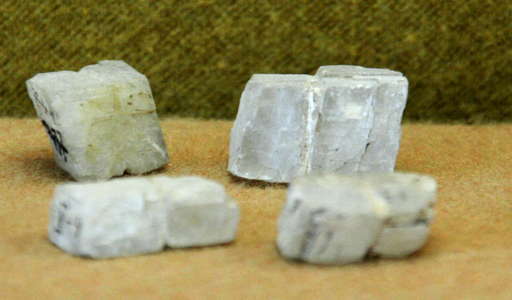Back to Don's Maps
Back to Venus figures from the Stone Age
The Mal'ta - Buret' venuses and culture in Siberia
The vast territory of North and Central Asia represents a poorly understood region in the prehistoric era, despite intensive excavations that have been conducted during the past century. The earliest human occupation in this region probably began sometime around 40 000 years ago. Small groups of big-game hunters likely migrated into this region from lands to the south and southwest, confronting a harsh climate and long, dry winters. By about 22 000 BP, two principal cultural traditions had developed in Siberia and northeastern Asia: the Mal'ta - Buret' and the Afontova Gora-Oshurkovo.The Mal'ta - Buret' tradition is known from a vast area spanning west of Lake Baikal and the Yenisey River. The site of Mal'ta is composed of a series of subterranean houses made of large animal bones and reindeer antler which had likely been covered with animal skins and sod to protect inhabitants from the severe, prevailing northerly winds. Among the artistic accomplishments evident at Mal'ta are remains of expertly carved bone, ivory, and antler objects. Figurines of birds and human females are the most commonly found items. The type sites are named for the villages of Mal'ta (Мальта), Usolsky District and Buret' (Буреть), Bokhansky District. The soft sign (Ь, ь), also known as the yer, translated into English as an apostrophe as in Mal'ta or Buret', makes the preceding consonant less pronounced.
The Mal'ta site is located on the left bank of the Belaya, a tributary of the Angara, itself a tributary of the Yenisei, and it is one hundred kilometres northwest of Irkutsk and Lake Baikal. Discovered in 1928, it has had many excavations carried out successively by Sergei N. Zamiatnine, G. P. Sosnovskii and especially by Mr. Mikhail Gerasimov, who worked there for over thirty years.
Coordinates: 52.9°N 103.5°E
Mikhail Mikhaylovich Gerasimov (Михаи́л Миха́йлович Гера́симов) was born 2nd September 1907, in St. Petersburg, and died 21st 1970, in Moscow. He was a Soviet anthropologist-sculptor and archaeologist. Doctor of historical sciences (1956) and director of the laboratory of plastic reconstruction at the Institute of Ethnology of the Academy of Sciences of the USSR (1950-70).
Text from Wikipedia and Delporte (1979)
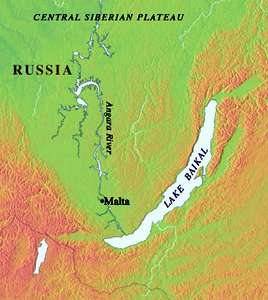
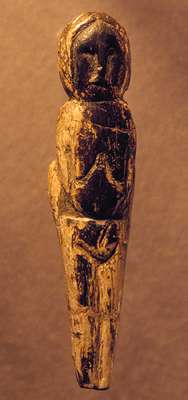
Map showing the location of Mal'ta (Siberia), and a venus figurine from Mal'ta.
The vast territory of North and Central Asia represents a poorly understood region in the prehistoric era, despite intensive excavations that have been conducted during the past century. The earliest human occupation in this region probably began sometime around 40 000 years ago. Small groups of big-game hunters likely migrated into this region from lands to the south and southwest, confronting a harsh climate and long, dry winters. By about 22 000 BP, two principal cultural traditions had developed in Siberia and northeastern Asia: the Mal'ta and the Afontova Gora-Oshurkovo.
The Mal'ta tradition is known from a vast area spanning west of Lake Baikal and the Yenisey River. The site of Mal'ta is composed of a series of subterranean houses made of large animal bones and huge numbers of reindeer antlers, no doubt scavenged for hut construction after being shed by the reindeer. The huts had likely been covered with animal skins and sod to protect the inhabitants from the severe, prevailing northerly winds bearing loess dust from the edges of the glaciated regions. Among the artistic accomplishments evident at Mal'ta are remains of expertly carved bone, ivory, and antler objects. Figurines of birds and human females are the most commonly found items.
Paleolithic art of Europe and Asia falls into two broad categories: mural art and portable art. Mural art is concentrated in southwest France, Spain, and northern Italy. The tradition of portable art, predominantly carvings in ivory and antler, spans the distance across western Europe into North and Central Asia. It is suggested that the broad territory in which the tradition of carving and imagery is shared is evidence of cultural contact and common religious beliefs. Some of the most well known examples are the so-called Venus figurines. One such figurine, illustrated here, is from the site of Mal'ta and dates to around 23 000 BP. It is carved from the ivory of a mammoth, an extinct type of elephant highly prized in hunting that migrated in herds across the Ice Age tundra of Europe and Asia. Like most Paleolithic figurine carving, the image is carved in the round in a highly stylised manner. Typically, there are exaggerated characteristics such as breasts and buttocks, which may have been symbols of fertility. Height 87 mm.
Laura Anne Tedesco
Department of Education, The Metropolitan Museum of Art
Photo and text: http://www.metmuseum.org/TOAH/HD/malt/hd_malt.htm
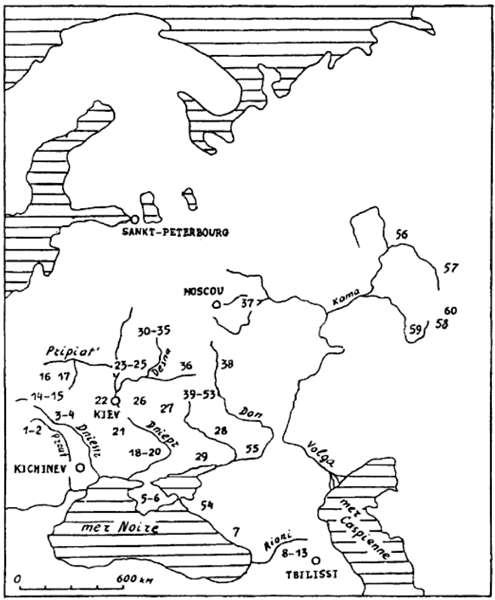
Distribution of mobile art in Eastern Europe.
1 Staryé Duruitory, 2 Brynzeny, 3 Kosseoutzy, 4 Klimaoutzy, 5 Suren' 1, 6 Chan-Koba, 7 Apiantcha, 8 grotte d'Uvarov, 9 Sakagia, 10 Sagvardgilé, 11 Gvardgilas-Kldé, 12 Devis-Khvreli, 13 Taro-Kldé, 14 Molodova V, 15 Lissitchniki, 16 Lipa VI, 17 Klinetz, 18 Ossokorovka, 19 Dubovaya Balka, 20 Kaïstrovaya Balka, 21 Mejiritch (Mezhirich), 22 Kievo-Kirillovskaya, 23 Mézine (Mizyn), 24 Novgorod Severskyi, 25 Puchkari I, 26 Dobranitchevka, 27 Gontzy, 28, Rogalik, 29 Amvrossievka, 30 Eliseevitchi I, 31 Eliseevitchi II, 32 Yudinovo, 33 Khoylevo II, 34 Timonovka, 35 Suponevo, 36 Avdeevo, 37 Sungir', 38 Gagarino, 39 Kostienki 19, 40 Kostienki 21, 41 Kostienki 13, 42 Kostienki 1, 43 Kostienki 14, 44 Kostienki 12, 45 Kostienki 17, 46 Kostienki 2, 47 Kostienki 11, 48 Kostienki 4, 49 Kostienki 15, 50 Kostienki 9, 51 Kostienki 8, 52 Borchtchevo 1, 53 Borchtchevo 2, 54 Ilskaya, 55 Murakovka, 56 Ostrovskaya, 57 Bez'imyannyi, 58 Smelobskaya, 59 Kapova, 60 Ignatievskaya.
Photo: Abramova (1995)
The Mal'ta - Buret' culture is an archaeological culture of the Upper Paleolithic (ca. 18 000 to 15 000 BP) on the upper Angara River in the area west of Lake Baikal in the Irkutsk Oblast, Siberia, Russian Federation. The type sites are named for the villages of Mal'ta (Мальта), Usolsky District and Buret' (Буреть), Bokhansky District.
Mal'ta consists of semi-subterranean houses that were built using large animal bones to assemble the walls, and reindeer antlers covered with animal skins to construct a roof that would protect the inhabitants from the harsh elements of the Siberian weather. Much of what is known about Mal'ta comes from Russian archaeologist Mikhail Gerasimov. Known in the anthropological community primarily for his contributions to a process called forensic sculpture (the recreation the face of an individual from skeletal remains), Gerasimov first achieved fame for his excavation of Mal'ta in 1927. At the time the discoveries he made were revolutionary for the field of anthropology. Until his findings scientists had not imagined that Upper Paleolithic societies of Northern and Central Asia were capable of the same level of culture as those of Europe. Over the course of his career Gerasimov would twice more visit Mal'ta for excavation and research, each time completing findings that were just as remarkable.
Evidence seems to indicate that Mal'ta is the most ancient site in eastern Siberia, however relative dating illustrates some irregularities. The use of flint flaking and the absence of pressure flaking used in the manufacture of tools, as well as the continued use of earlier forms of tools seem to confirm the fact that the site belongs to the early Upper Paleolithic. Yet, it lacks typical skreblos (large side scrapers,) that are common in other Siberian Paleolithic sites. Additionally, other common characteristics such as pebble cores, wedge-shaped cores, burins, and composite tools have never been found. The lack of these features, combined with an art style found in only one other nearby site, make Mal'ta culture unique in Siberia.
(text above from Wikipedia)
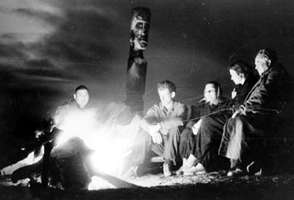
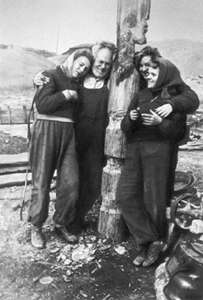
Mikhail Gerasimov with his colleagues in archaeology during the excavations at Mal'ta, 1957 and 1958.
Photo: http://www.kunstkamera.ru/en/temporary_exhibitions/virtual/gerasimov/02/
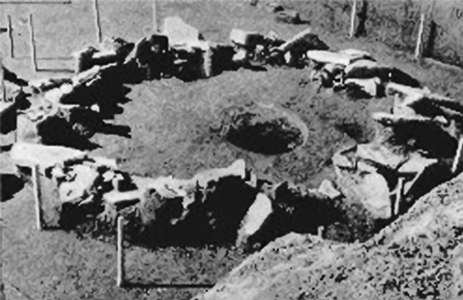
Circular dwelling made with a stone wall base, from Mal'ta, Siberia.
Photo: http://www.afghanchamber.com/history/stoneages.htm
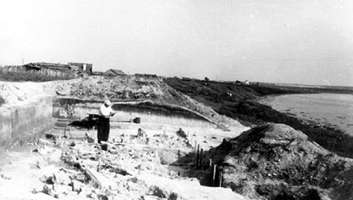
Mikhail Gerasimov during the excavations at Mal'ta, Siberia, 1958. The habitat occupied the edge of the terrace, parallel to the river bed. He is standing on the archaeological layer of Mal'ta, on the terrace, which is 400 metres long, and the archaeological layer had an average width of 20 metres.
Photo: http://www.kunstkamera.ru/en/temporary_exhibitions/virtual/gerasimov/02/
The site is located on a terrace of 15-18 metres and is buried in loessic formations, which are attributed to glaciation. According to Gerasimov, stratigraphy is presented, from top to bottom, as follows:
1. topsoil (thickness: 40 cm to 50 cm).
2. silty layer of dark brown colour (approximate thickness 20 cm) at the top of which were found the remains of the first archaeological layer, of which is known only a small area, about 30 square metres, while the lower archaeological layer is known over an area of 8000 square metres. The material collected in this first layer is assigned by Gerasimov to the Upper Palaeolithic of Europe, the Azilo-Tardenoisian. It consists mainly of large scrapers of Mousterian type, sometimes bifaces, as well as some small nucleus in slices, so it is probably an industry that is similar to the third or fourth stage of the Siberian Paleolithic.
3. light yellow clay, more or less cracked, barren, thickness: 40 to 50 cm.
4. silt of darker yellow appearance, laminated (thickness: 30 to 45 cm), which seems to form the upper soil layer containing the principal archaeological finds of Mal'ta.
5. dark yellow loam, more clayey, with lenses of coarse sand and reddish clay (average thickness: 50 cm).
6. clayey sand, gradually rising to a formation of pebbles, this layer, whose total thickness is 3 metres, lies on the Cambrian limestone bedrock. This main archaeological layer of Mal'ta is known for a length of 400 metres and an average width of 20 metres. It seems that the habitat occupied the edge of a terrace, parallel to the river bed.
According to Gerasimov there existed in Mal'ta three housing types: the first, preserved in the form of circular lenses of 3.5 to 4 metres in diameter, probably corresponds to huts built of poles covered with skins and also using reindeer antlers for support, and with a central fireplace. These are probably summer homes.
The second type is represented by more or less rectangular houses of with average dimensions of about 4 metres by 3 metres and were semi-subterranean, in that they were excavated, 50 cm to 70 cm into the earth, but they also had small walls rising above the ground using stone slabs arranged vertically , as well as large animal bones, especially mammoth and rhinoceros, with the roof formed by poles and skins, and strengthened by antlers; this general structure of this type of housing directly recalls the houses that were identified at Gagarino.
In the centre of these houses, the fireplace was sometimes raised above ground level and was formed by three stone slabs, and topped with ash, burnt bone and charcoal, as well as fragments of wood (birch, fir). Around the fireplace, there were often collections of small pieces of ivory, and female statuettes. Thus, in one of these houses, Gerasimov found four statuettes, including three close together.
The third type of habitat is represented by at least two houses, also rectangular and semi-subterranean, built using the same technique the previous ones, but larger. One of them, excavated in 1956, measured 14 metres long by 6 metres wide. These large dwellings had several fireplaces. Gerasimov thinks they were winter houses.
It should be emphasised that, unlike the Russian houses of, say, Kostienki and Zaraysk, those of Mal'ta do not have the many and varied pits that they have. There were only a few small pits containing the skeletons of animals at Mal'ta.
The archaeological material from the main layer of Mal'ta was collected mainly inside the houses. However, outside, and often on the slope of the terrace, below the living area and above the river, lots of waste was found that may have been thrown out of the houses, and in which were gathered a number of objects, usually arranged higgledy piggledy.
Text above translated and adapted from Delporte (1979)
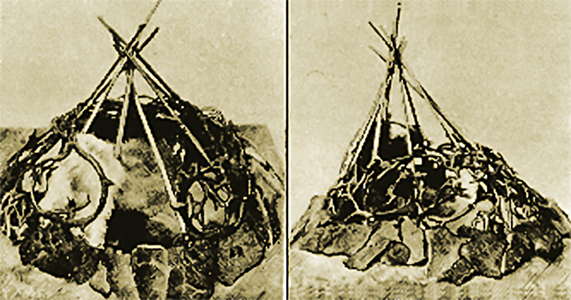
Circular tents from Mal'ta, Siberia. These animal hide covered structures were bolstered with stones at the base.
Photo: http://www.afghanchamber.com/history/stoneages.htm
It is the female figures which form the series of the most important works of Mal'ta: during the various excavations, the number found has been raised to twenty-nine statues, or fragments of statues, of women.
Despite some differences, the series presents a remarkable homogeneity, and it is convenient therefore, not to examine them individually, but to draw an identikit picture for them, except to report items that may vary. The Mal'ta series of figurines has twenty-three statuettes either whole or nearly whole, plus three blanks and three fragments, two separate heads. Only two statues are made of reindeer antler, the rest of the series is mammoth ivory. The average height is 72 mm.
Text above: Delporte (1979)


Figurine, Mal'ta, height 96 mm.
Although the largest of this group of figurines measures 136 mm and the smallest 31 mm, still they fall into two major groups, with the first having heights from 40 to 45 mm, the second group having heights between 85 and 95 mm. The general proportions of the body do not present at Mal'ta, as they do at Gagarino or Brassempouy, an element of homogeneity: next to slender figures and sometimes very elongated, almost 'filiform' examples, one finds others which, without being truly obese, are at least massive and heavy. The emphasis on detail also varies from one to another statuette, sometimes even from one part to another of the same statue, for example the example here whose face and hair are very neat, but the rest of the body is represented by a cylindrical rod, on which are engraved the pubic triangle, and on both sides, just a line separating one leg from the other.
Photo: http://www.nihilum.republika.pl/
Text: Delporte (1979)

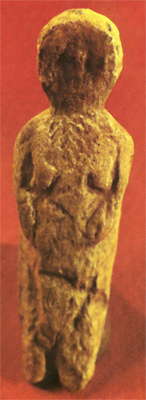
Female figurine. Mammoth ivory, Mal'ta.
Photo (left): http://www.kunstkamera.ru/en/temporary_exhibitions/virtual/gerasimov/02/
Photo (right): Jelinek (1972)
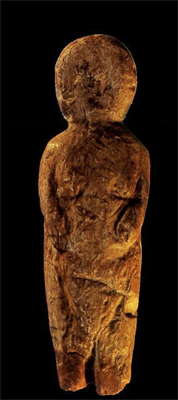
Mal'ta figurine, another version of the ones above.
Photo: http://www.istmira.com/foto-i-video-pervobytnoe-obschestvo/3924-iskusstvo-predystorii-pervobytnost-2.html
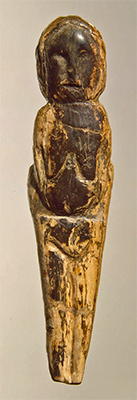
Female figurine.
Mammoth tusk; engraved. Height 87 mm.
Maltinsko-buretskaya Culture. 23 000 - 19 000 BP
Mal'ta Site (Excavations of M.M. Gerasimov, 1928-1930), Siberia, the River Belaya, near Irkutsk, Russia
Photo and text: http://www.hermitagemuseum.org/
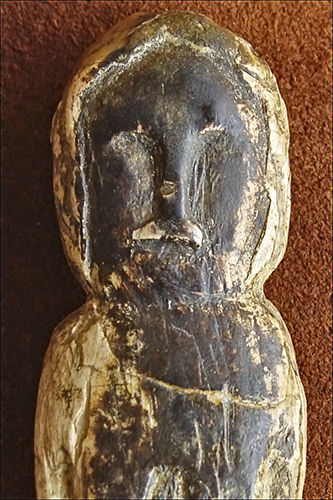
Female figurine, Mal'ta.
A close up of the face of the venus above.
Photo: Lyudmila Lbova, Hermitage Museum
Source: http://siberiantimes.com/
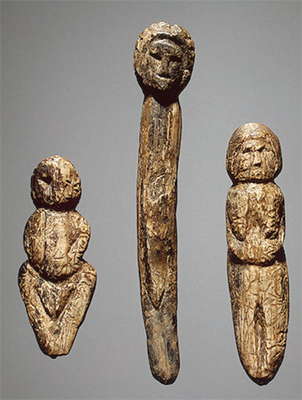
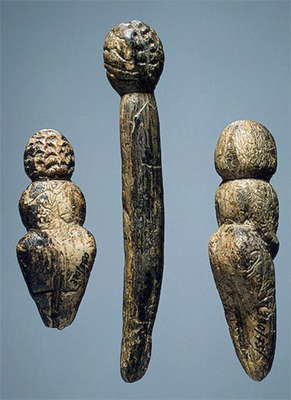
Female Figurines.
Mammoth tusk; carved and polished. H. 53, 96, 71 mm.
Mal'ta Site (excavations by M.M. Gerasimov, 1928-1930),Siberia, the River Belaya, near Irkutsk, Russia
Maltinsko-buretskaya Culture. 23 000 - 19 000 BP
Photo and text: http://www.hermitagemuseum.org/
(Some of these figurines remind me irresistibly of children's dolls! - Don )
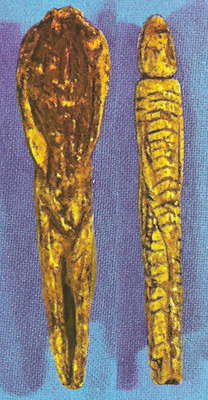
Venus figures from Mal'ta (Siberia).
Photo: Jelinek (1972)

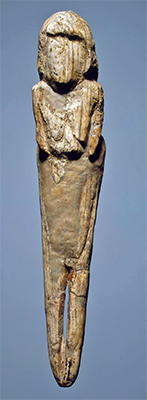
Venus figure 134 mm high, 22 000 - 21 000 BP
Photo:
(left) Jelinek (1972)
(right) http://www.hermitagemuseum.org/
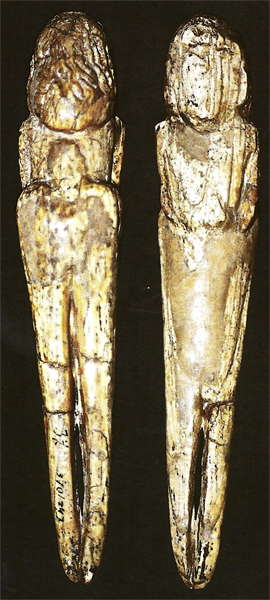
This figurine was discovered by Gerasimov near Irkutsk around 1928.
87 mm high. (note discrepancy with height given above - Don)
Mammoth Ivory, 22 000 BP, Hermitage Museum, Saint Petersburg, Russia.
Photo: Cohen (2003)
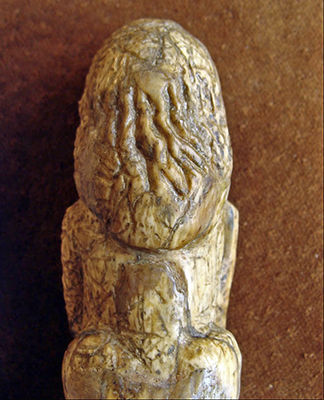
The back of the head of the figurine above. This may be a fur head covering.
Mammoth Ivory, 22 000 BP, Hermitage Museum, Saint Petersburg, Russia.
Photo: http://siberiantimes.com/

Another venus head.
Photo: http://siberiantimes.com/
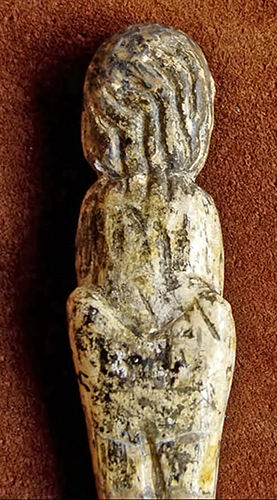
A venus showing what may be a hair style.
Photo: http://siberiantimes.com/
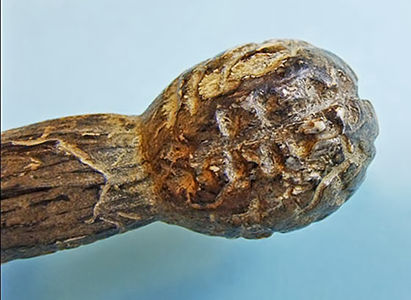
Head of one of the long thin venus types.
Photo: http://siberiantimes.com/

The back of this venus has been described as having a backpack etched on it by Dr Lyudmila Lbova.
Photo: http://siberiantimes.com/
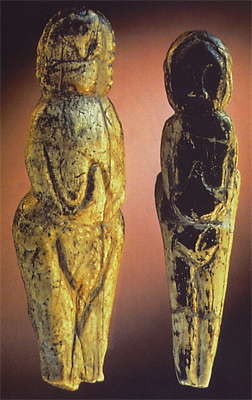
Venus figures from Mal'ta (Siberia).
Photo: http://www.mitchellteachers.net/WorldHistory/MrMEarlyHumansProject/MrMAnalyzingPaleolithicArtAssignment.html
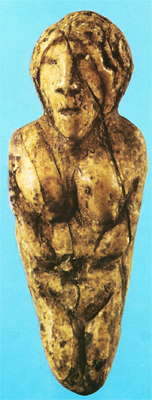
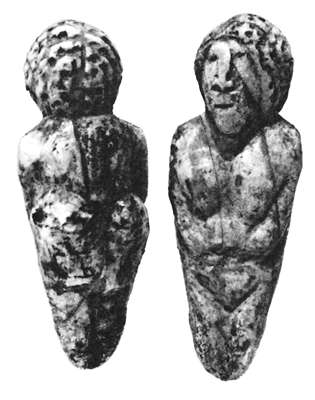
Female figurine, Mal'ta.
Photo: Jelinek (1972)
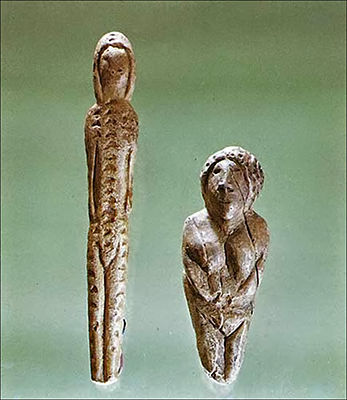
Female figurines, Mal'ta.
Photo: Science First Hand, Hermitage Museum
Source: http://siberiantimes.com/
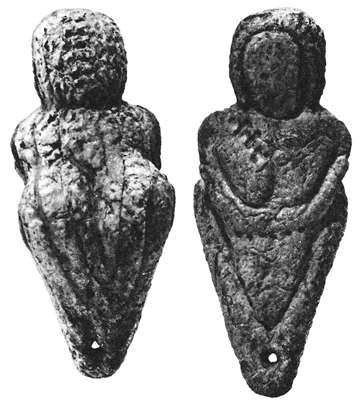
Female figurine, Mal'ta.
Photo: Jelinek (1972)
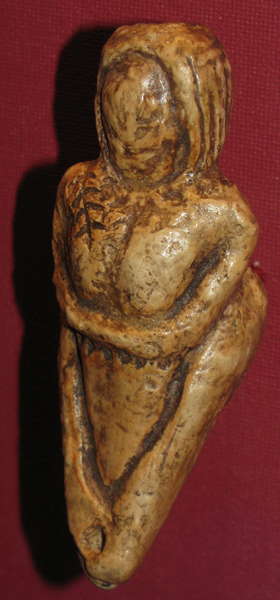

Venus figure from Mal'ta (Siberia), the same as that shown above.
Note the pinnate leaf shaped mark on the right breast of this figurine, and the hole drilled in the base, presumably so that it could be worn as a pendant.
The arms are joined below the breasts, the hands are not indicated, and the figure has what appears to be a fur hood over her head. The legs are shown meeting at the base of the figurine.
Below the arms is what appears to be a belt consisting of linked disks.
Note the raised buttocks evident on this piece, a defining characteristic of many Mal'ta figurines.
Photo: Don Hitchcock, 2008
Source: Facsimile, Vienna Natural History Museum


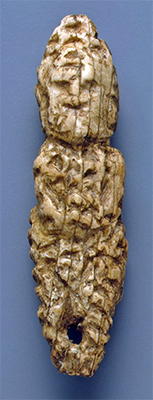
(left) Figurine, Mal'ta, Height 42 mm, Width 8 mm
(right) Figurine, Mal'ta. At first the head on this piece looks grotesquely wide and high, but I think it is just the effect of a face peeking out from a fur head dress. Height 44 mm.
Twenty heads are known, isolated or belonging to figurines, but two of them are mere sketches. For all the others, the hair, or hairstyle, is shown. It should be pointed out, however, that in several cases as shown here it is a hairstyle, such as a 'balaclava', for which the hairstyle is indistinguishable from that of clothing.
In any case, the hair or hairstyle is long, often narrowly framing the face and falling down the back. For two or three statuettes, this hairstyle is represented only in outline, but more generally, it is marked by incisions, which may be of several types: relatively straight and following the natural movement of long hair, wider and wavy, but mostly in the form of small crescents arranged in various ways or from small circular cupules.
Photo (left): http://www.nihilum.republika.pl/
Photo (right and centre): http://www.hermitagemuseum.org/
Text: Delporte (1979)

An in-depth study of the Mal'ta Venuses conducted by Dr Lyudmila Lbova (photo at left) and Dr Pavel Volkov of the Russian Academy of Sciences has determined that the figurines are not idealised nude females, but depictions of clothed individuals - many of them depicting men, teenagers, and children.
Through microscopic examination and macro photography, Drs. Lbova and Volkoy were able to discover traces of lines that were not able to be seen by the naked eye due to ravages over time. These lines depicted more details of clothes that were not previously seen such as bracelets, hats, shoes, bags, and even back packs. The team also discovered that the creators of the figurines depicted different hats, hairstyles, and other accessories, and use different carving techniques to highlight the different materials such as fur and leather.
Although the function of these figurines are still unknown, it is clear from the study that the Venus/Mother Goddess connotations attached to these figurines will have to be completely reevaluated. According to Dr. Lbova: 'What we can say for sure is that these realistic details of clothes, accessories, hairstyle clearly show that ancient masters made the figurines of some real people, maybe their relatives. I strongly doubt that these were the images of abstract goddesses or spirits in the sense often used to understand so-called Venus depictions.'
Photo: © Vera Salnitskaya
Source: http://siberiantimes.com/
Text: adapted from http://fuckyeaharchaeology.tumblr.com/post/139873235297/siberian-venus-figurines-are-not-venuses-after
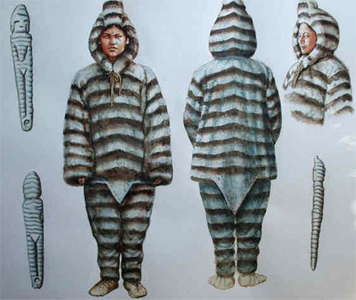
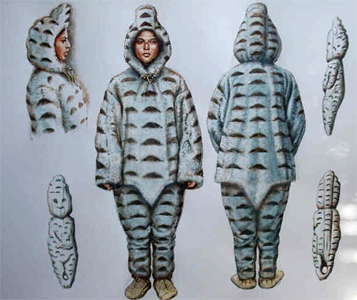
Fur clothing which may have been used at Mal'ta.
Photo: © Libor Balák
Source: http://paleoetnologie.wz.cz/anglperson.htm
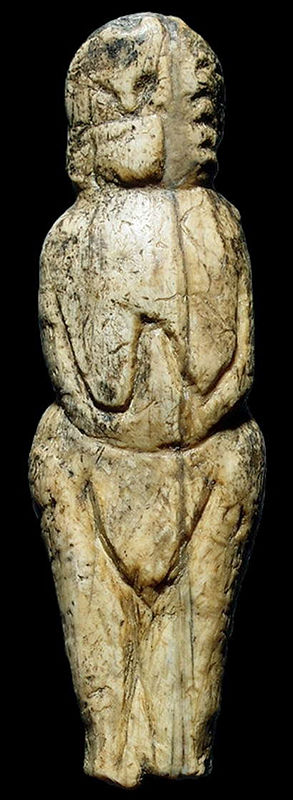
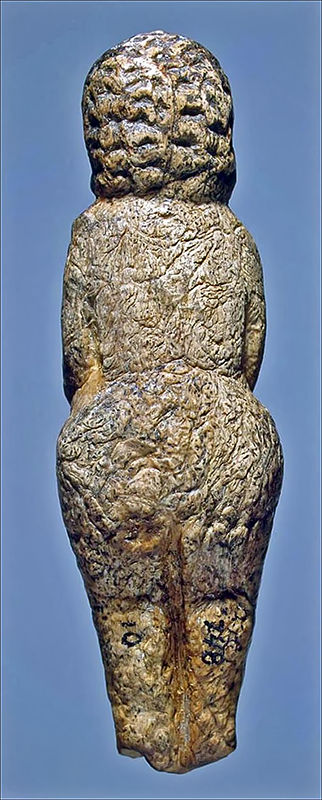
Female figurine, Mal'ta.
Note the texture on the back of this piece.
Height 94 mm.
Text from http://siberiantimes.com/ :
Sophisticated lines show the the different materials of which the clothes were made.
( note that the texture looks to me more like an artefact of differential erosion because of the long period the piece had been buried, and the possible depredations of invertebrates on the surface of the piece.
However, the front of the piece has not been so textured, so perhaps it was deliberate after all - Don )
Photo (left): http://www.nihilum.republika.pl/
Photo (right): Lyudmila Lbova, Hermitage Museum, Source: http://siberiantimes.com/
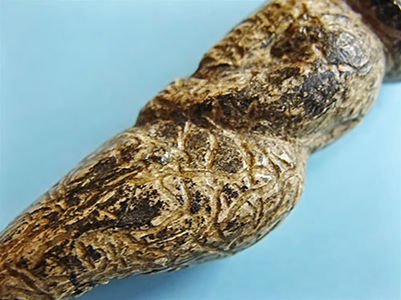
Female figurine, Mal'ta.
A view of the venus above from one side.
Photo: Lyudmila Lbova, Hermitage Museum
Source: http://siberiantimes.com/
One of the most peculiar characteristics of the Mal'ta statuettes is the representation of facial features, which representation, we should remember, is exceptional among the figures of the preceding groups: on the eighteen heads that are not drafts, eleven have clear facial features, and three more are outlined.
The eyes, nose and mouth are sometimes depicted with care, although the ears are hidden by thick hair or a hairstyle. The head position is different from that observed for most European statuettes, among which, in fact, the head is slightly bent forward and supported by a thin and well marked neck, in the sense that its width is generally less than or equal to two thirds of that of the head.
In Mal'ta, the head is a direct extension of the torso, to which it is attached by a poorly marked neck whose thickness is increased by that of the hair or of the hairstyle coming down on each side to the shoulders. The torso of Mal'ta figures also differs from that of European statuettes, in that the European venus figures are characterised, generally, by the excessive volume of body parts linked to femininity or motherhood: large breasts, most commonly hanging, a large and prominent belly suggesting pregnancy. This is not the case in Mal'ta: for more than half of the statuettes, the breasts are missing; on the other, they are not figured in volume, but only by an outline engraved on the chest, an outline that also shows pendant breasts; on the belly, the navel, which is not indicated, is always flat.
Like the belly, the pelvis is hardly wider than the chest and is usually developed without steatopygia (large buttocks) or localised fat deposits due to genetics. The pubic triangle is always represented, either in the form of a small V, or in the form of a large triangle reminiscent of the ultra-stylised figurines of Mizyn but there is no representation of vulva.
On the posterior, buttocks are normal. The small of the back is shown, sometimes very elevated. If we compare, by looking at them in profile, a statuette of Kostenki and a statuette of Mal'ta, we observe, on the first, a step between the buttocks and thighs, something which does not exist or is only hinted at in the Mal'ta figures. By contrast, we see a sharp elevation or step above the buttocks of Mal'ta figurines. It is this elevation that, combined with a certain extension of the legs for some statuettes, suggested the hypothesis that many of the statuettes of women from Mal'ta are in a semi-sitting position.
Most of the Mal'ta figurines have arms, sometimes only sketched, but generally not atrophied, unlike those of many European Venus figures. The hands are missing. We must emphasise that the position of the arms, down along the body to rest on the belly is identical to that of the statues of the European groups. The lower limbs are simplified, albeit in the correct proportions, but they are usually reduced to a kind of spindle more or less ending in a point. The thighs are not particularly more massive than the legs. The articulation of the knees and feet are never indicated.
Separation of legs from each other is usually marked by a shallow incision on each side, in one case only, the two incisions are joined in a sort of elongated buttonhole. It should be noted that four more figurines bear a perforation in the feet.
A final descriptive element of these statuettes concerns their clothing and adornment.
These cases seem to be distinguished:
a. most statuettes of Malta, like those of Europe, have no trace of clothing or adornment. But the forms are sometimes heavy and often quite 'fuzzy', suggesting the possibility of a garment wrapped closely, tight around the whole body: the impression of nudity is, in any case, less convincing than for European statuettes.
b. several small figurines are undoubtedly dressed: the whole body, including the head - except for the face - is uniformly covered with a decoration that can interpreted as belonging to a fairly tight garment. This decoration is formed by small crescent-shaped cupules or, more often, by transverse incisions, of the type of a 'convict costume', which follow from the top of the head down to the feet. It should be noted that these dressed statuettes do not have breasts, but the pubic triangle is clearly incised: they are indeed female statuettes.
Text above: Delporte (1979)


Figurine, Mal'ta.
Height 125 mm.
Photo (left): http://www.hermitagemuseum.org/
Photo (right): http://www.nihilum.republika.pl/
Differences between the Mal'ta / Buret' Figurines and those of the Kostenki culture
| Kostenki venus figures | Mal'ta - Buret' venus figures | ||
| Head | A | Hair or hairstyle relatively short, occupying the upper part of the skull, or hair or hairstyle, not shown. | Hair or hairstyle long, framing the face. |
| Hair or hairstyle exceptionally marked by incisions of various shapes. | Hair or hairstyle usually marked by incisions, often in the form of small crescents. | ||
| B | Facial features absent (they occur indistinctly on a single isolated head). | Facial features shown (14 examples of 23 figures). | |
| Neck | C | Neck shown clearly, neck width less than or equal to 2/3 of the width of the head. | Neck hardly indicated. |
| Torso | D | Breasts modelled, more or less voluminous. | Breasts flat or absent, they are only shown by engraving on the torso. |
| E | Belly more or less prominent. | Flat stomach. | |
| Lower limbs |
F | Pelvis significantly wider than the torso. | Pelvis same width as the torso. |
| G | Indentation (in profile) between the buttocks and thighs. | Indentation (in profile) between the small of the back and the buttocks (buttocks raised). | |
| H | Articulated leg (bent knees). | Non-articulated legs (legs straight). | |
| I | Lower ends of legs separated from one another, without basal perforation. | Legs ending in a point, sometimes with basal perforation (6 cases). | |
| Clothing | J | No clothing, or simple bands of ornament. | Clothing sometimes indicated over the whole body. |
| Style | Modelled sculpture. | Modelling much more mediocre; secondary relief (breast, stomach) are not shown, the whole figure retains the shape of the original raw material. |
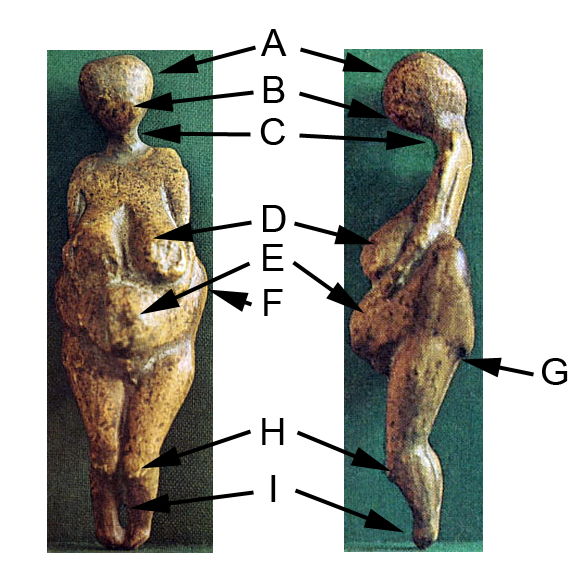
Kostenki figurine with the features as shown in the table above.
Diagram: Don Hitchcock, after Delporte (1979)
Photo: Clark (1967)
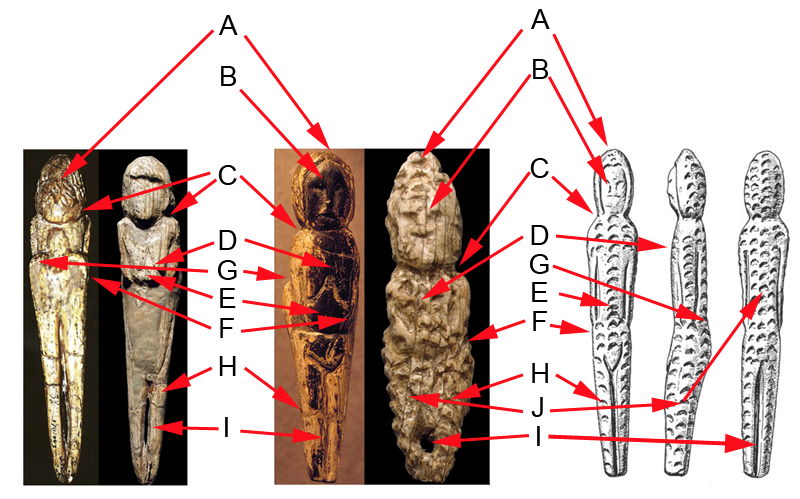
Mal'ta / Buret' figurines with the features as shown in the table above.
Left, back and front of a single Mal'ta figure, middle, two different figures from Mal'ta, right, front, side and back of a single figure from Buret'.
Diagram: Don Hitchcock, after Delporte (1979)
Photos: Cohen (2003), Jelinek (1972), http://www.metmuseum.org/TOAH/HD/malt/hd_malt.htm, http://www.nihilum.republika.pl/, http-//www.folklore.ee/folklore/vol18/pa06.pdf
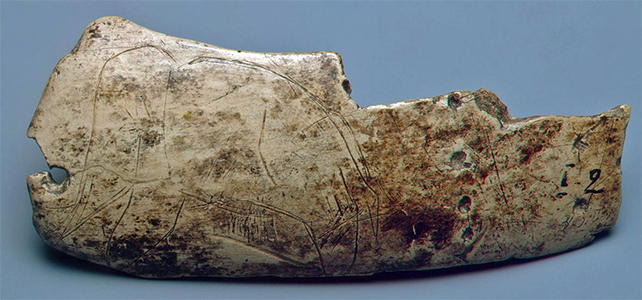
Fragment of a mammoth tusk showing a mammoth.
Mammoth tusk; carved, polished and engraved. 83 x 32 mm
Maltinsko-buretskaya Culture. 23 000 - 19 000 BP
Malta Site (Excavations of M.M. Gerasimov, 1928-1930), Siberia, the River Belaya, near Irkutsk, Russia
Photo and text: http://www.hermitagemuseum.org/
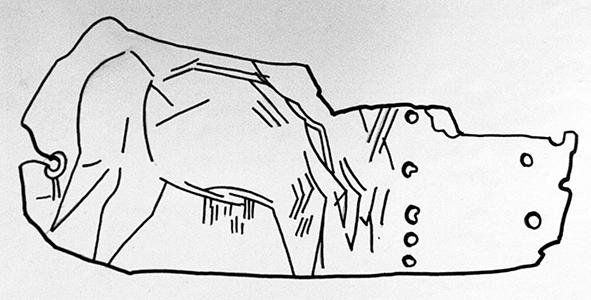
Interpretation of the mammoth sketch above.
Photo: Vladimir Gorodnjanski 2014
Source: The Hermitage Museum, Saint Petersburg
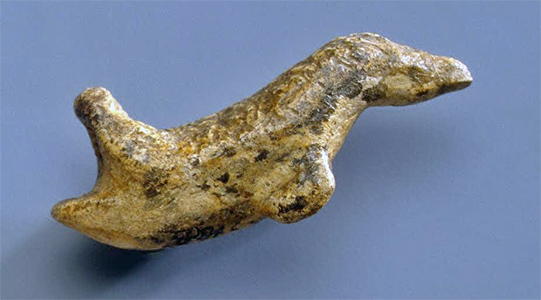
Pendant shaped like a swimming bird.
Mammoth tusk; carved. 42 x 17 mm
Maltinsko-buretskaya Culture. 23 000 - 19 000 BP
Malta Site (Excavations of M.M. Gerasimov, 1928-1930), Siberia, the River Belaya, near Irkutsk, Russia
Photo and text: http://www.hermitagemuseum.org/
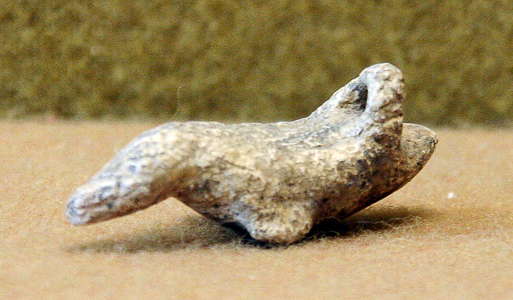
Pendant shaped like a bird, apparently a duck or similar short necked water bird
This looks almost identical to that above but from a different angle, clearly showing the loop carved so that the object could be hung from a cord, but the surface texture is quite different. Perhaps one or both are facsimiles of the same original.
Photo: Vladimir Gorodnjanski
Source: The Hermitage Museum, Saint Petersburg
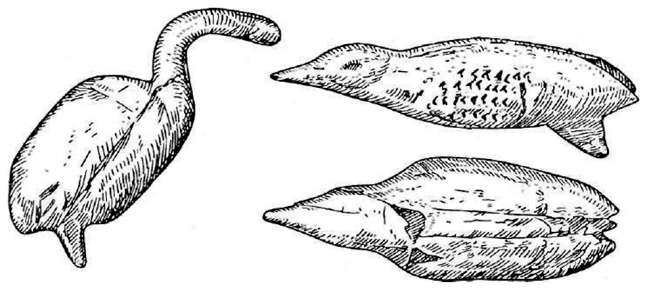
Carved birds from the Mal'ta site.
Three realistic depictions of birds come from Mal'ta. The most interesting are a statue of a swan, with the body, neck and legs, which was discovered in 1957, and a statuette, collected in 1956, which Gerasimov believes to be a representation be a partridge. The head is well represented, with the beak, the body has realistic proportions, the wings are represented by series of small chevron incisions.
Photo: ftp://fulltext.mubis.ru/fulltext/histsib1/text/histsib1_text.pdf
Text: Delporte (1979)
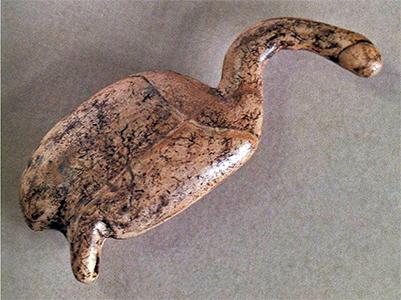
Carved bird, as in the Delporte (1979) image above.
Photo: http://www.mrugala.net/Histoire/Prehistoire/Images/index.php?page=2
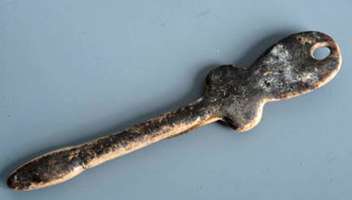
There are thirteen or fourteen representations of stylised birds at Mal'ta, found during the excavations of 1956 - 1957, in the 'male habitat' areas, to the right of the fireplaces.
They are made of mammoth ivory and, although their dimensions are unequal - the largest measuring 150 mm, and the smallest 50 mm, they are, by their form and style, remarkably homogeneous. The head has an irregular rhomboid outline, pointed upward and reminiscent, both in its form and how it connects to the neck, of the head of a snake. It carries no figurative detail.
Photo: http://www.kunstkamera.ru/en/temporary_exhibitions/virtual/gerasimov/02/
Text: Delporte (1979)
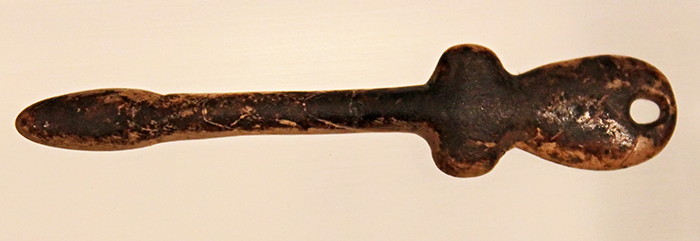
The neck is represented by an elongated slender cylinder, and as for most of these statuettes, its length is greater than half the total length of the figurine.
Photo: Ralph Frenken
Text: Delporte (1979)
Source: Original, exhibited at the Archeological Museum Hamburg (Ice Age - The Art of the Mammoth Hunters from 18 October 2016 to 14 May 2017)
On loan from the Hermitage Museum, Saint Petersburg, Russia.
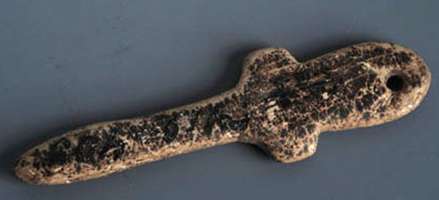
The base of the neck, thicker, connects to the body, and expands to form two lateral appendages, more or less bulky, which may include the wings of the bird on several of the statuettes.
These appendages have been defined, at their lower part, by two lateral notches.
Photo: http://www.kunstkamera.ru/en/temporary_exhibitions/virtual/gerasimov/02/
Text: Delporte (1979)

The body itself, of more or less ovoid, always has a perforation at its base, sometimes broken.
It is likely that these statues are representations of birds, but it seems worth pointing out the aspect ratios that may exist between them and the female idols, violin-shaped, which have been encountered in the Neolithic deposits of the Eastern Mediterranean and into the Caucasus.
Photo: Ralph Frenken
Text: Delporte (1979)
Source: Original, exhibited at the Archeological Museum Hamburg (Ice Age - The Art of the Mammoth Hunters from 18 October 2016 to 14 May 2017)
On loan from the Hermitage Museum, Saint Petersburg, Russia.
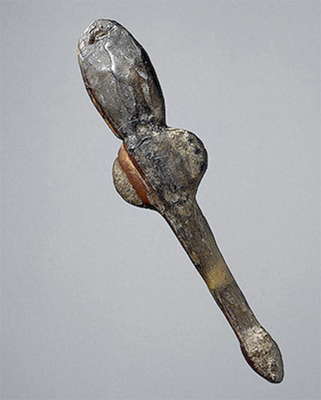
Figurine of a flying bird
Mammoth tusk; carved and polished. 60 x 50 mm
Maltinsko-buretskaya Culture. 23 000 - 19 000 BP
Malta Site (Excavations of M.M. Gerasimov, 1928-1930), Siberia, the River Belaya, near Irkutsk, Russia
Photo and text: http://www.hermitagemuseum.org/
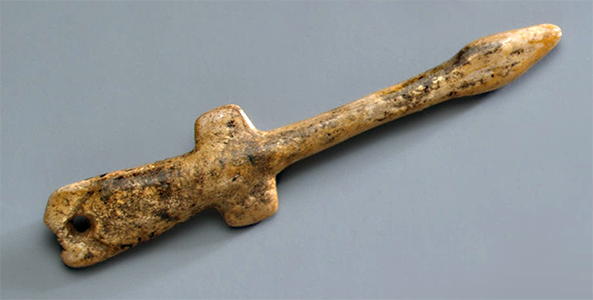
Pendant shaped like a flying bird
Mammoth tusk; carved. 78 x 17 mm.
Maltinsko-buretskaya Culture. 23 000 - 19 000 BP
Malta Site (Excavations of M.M. Gerasimov, 1928-1930), Siberia, the River Belaya, near Irkutsk, Russia
Photo and text: http://www.hermitagemuseum.org/

Pendant shaped like a flying bird.
Mammoth tusk.
This piece has meandering carvings across it, possibly from root etching.
Chemicals secreted by roots etch the surface when bone or ivory are in the root zone of plants.
Photo: Vladimir Gorodnjanski
Source: The Hermitage Museum, Saint Petersburg
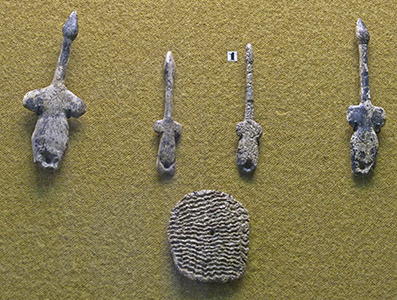
Bird sculptures and a flat plate with wriggly lines across it, and a hole in the middle.
Photo: Vladimir Gorodnjanski 2014
Source: The Hermitage Museum, Saint Petersburg

Pendants shaped like flying birds
Mammoth tusk; carved. Heights 117, 103, 100 mm.
Maltinsko-buretskaya Culture. 23 000 - 19 000 BP
Malta Site (Excavations of M.M. Gerasimov, 1928-1930), Siberia, the River Belaya, near Irkutsk, Russia
Photo and text: http://www.hermitagemuseum.org/
 Rod decorated with cupules. This decoration of cupules is common in the Mal'ta tradition.
Rod decorated with cupules. This decoration of cupules is common in the Mal'ta tradition.
Photo: Vladimir Gorodnjanski 2014
Source: The Hermitage Museum, Saint Petersburg
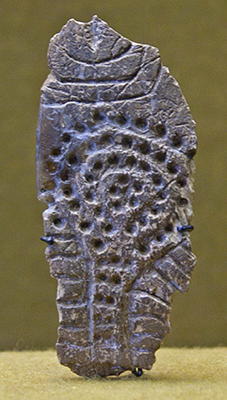


Plate and rod (both ivory?) decorated with lines and cupules.
Photo: Vladimir Gorodnjanski 2014
Source: The Hermitage Museum, Saint Petersburg
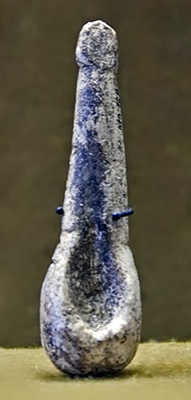
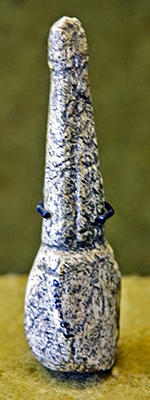
(left) This is an odd object, somewhere between a spoon and a venus figure.
(right) This appears to be an ébauche, a rough unfinished version of a venus figure, obviously from the same culture as the object on the left. It appears to have vestiges of the outline of a pubic triangle.
( Ralph Frenken notes (pers. comm.) that both fit into the large male/female category of venus figures, in that each of them is shaped like a phallus - Don )
Photo: Vladimir Gorodnjanski 2014
Source: The Hermitage Museum, Saint Petersburg
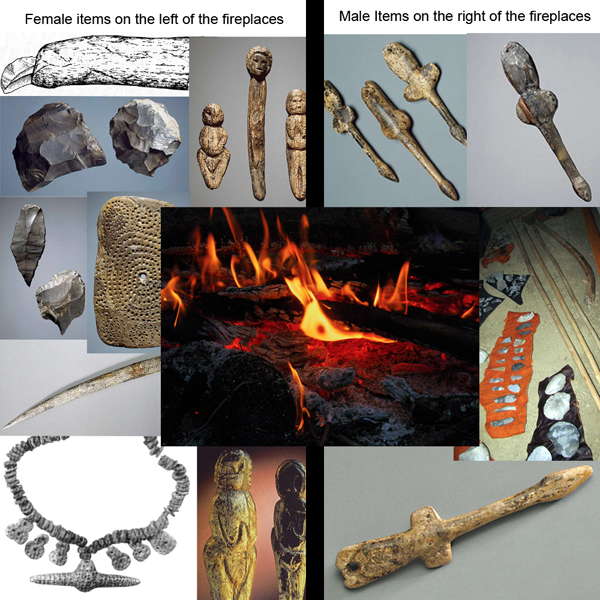
An important result was reported by Gerasimov with regard to a regularity in the distribution of the artefacts:
"… the male equipment (hunting weapons and bird figurines) was found to the right of the fireplaces. The female equipment (knives, scrapers, needles, awls, ornaments, statuettes of women) was found on the left (Gerasimov)." A similar observation was made in 1957 during the excavation of the circular house number 5:
"Along the walls, the objects were divided into two groups: a male group (knives, bifaces, bone daggers, bird figurines) and a female group (necklaces of ivory, decorated objects, needles, awls, scrapers, knives , female statuette)."
This is the first time such a distribution has been observed within a Paleolithic habitat , and it is conceivable how such an observation may be of interest. Moreover, it is equally important to remember that, at least in Mal'ta, the female statuettes are part of the female objects, while the figures of birds belong to the masculine objects.
(Note that Soffer et al. (2001) are not as convinced as Gerasimov about this interpretation. They do not apparently dispute the division of items left and right of the fireplaces, but question whether the sides can be assigned to genders - Don )
Text: Translated and adapted from Delporte (1979)
Photo: Assembled by Don Hitchcock from various sources, including http://www.hermitagemuseum.org/, http://www.mitchellteachers.net/WorldHistory/MrMEarlyHumansProject/MrMAnalyzingPaleolithicArtAssignment.html, Sklenar (1988), http-//www.folklore.ee/folklore/vol18/pa06.pdf. The fireplace photo and the one of the spears are from Don Hitchcock.
Perfectly preserved at Mal'ta were the remains of homes, above ground, investigated by Gerasimov. One was marked by a ring of massive slabs of limestone, with a diameter of 4.5 metres. Even at the time of excavation, some of these slabs were still in their original position, vertically dug into the ground, just as they were 25 000 years ago. In the floor of the dwelling, almost exactly in the centre, was a hole for a hearth in the form of a cup, whose bottom was lined with thin slabs of limestone, presumably to keep the fire dry and stop the permafrost below from interfering with the fire. On one side were fragments of jade, knives made on blades, bone tips, and thin shavings of ivory - the remains of the Palaeolithic sculptor, with further out sculpted loons and swans. There were mammoth ivory necklaces, pendants made of calcite, buttons ornamented with carved zigzag lines, needles, awls, scrapers and knives. Occasionally there was a female figurine.
In these homes, they apparently did not use fat lamps, they simply kept a fire burning in the hearth for heat and light. This was the centre of the home, and the whole life of the inhabitants was centred around it. They made stone tools and weapons of bone and antler, as well as amazing works of art, including not just simple decorations, but also objects that show a true and realistic mastery of images created by talented artists of the ice age.
Among the art objects of Mal'ta and Buret' are unique sculptures, not known from anywhere else, of women dressed in furs. These sculptures represent one of the most expressive elements of the unusual pattern of life of the people who lived in arctic conditions, and not only survived, but prospered.
Text above translated and adapted from: http://www.siberia-history.ru/node/752

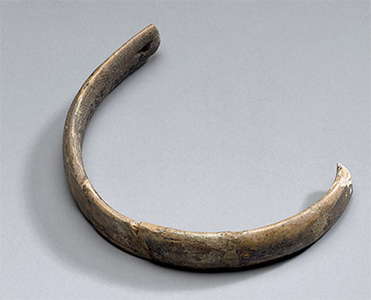
Bracelet.
Mammoth tusk; carved and polished. length 92 mm, diameter 40 mm.
Malta Site (excavations by M.M. Gerasimov, 1928-1930), Siberia, the River Belaya, near Irkutsk, Russia
Maltinsko-buretskaya Culture. 23 000 - 19 000 BP
Photo and text: http://www.hermitagemuseum.org/
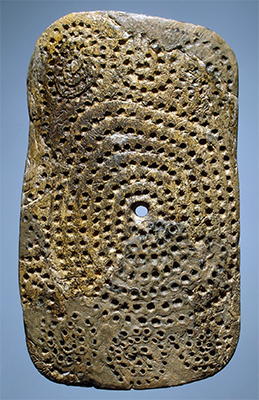
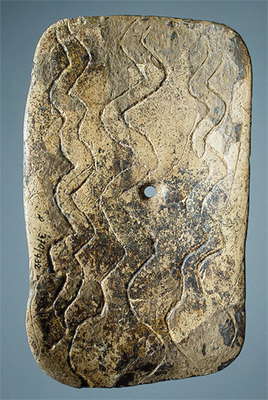
Plate with a hole in the centre.
Mammoth tusk; carved, polished and engraved. 138 x 81 mm.
Mal'ta Site (excavations by M.M. Gerasimov, 1928-1930), Siberia, the River Belaya, near Irkutsk, Russia
Maltinsko-buretskaya Culture. 23 000 - 19 000 BP.
On one side of the plate we can see three snakes. The snake is rare in northern hemisphere Paleolithic art, presumably because the cold conditions precluded a wide distribution of snakes. In addition, it can be seen that the snakes have very broad heads, as though they belong to the Cobra group - yet Cobras are now known only in southern asian localities.
Photo and text: http://www.hermitagemuseum.org/
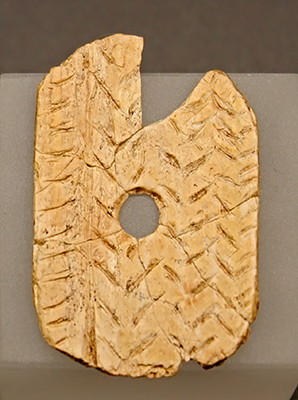
Perforated plate, Yudinovo, 15 000 BP.
This perforated plate is very similar to the one above from Mal'ta, although considerably smaller.
The function of this perforated plate is not clear. It could have been worn as a pendant, or have been used as an ornate button, or else have fixed individual parts of clothing.
Photo: Ralph Frenken
Source: Original, exhibited at the Archeological Museum Hamburg (Ice Age - The Art of the Mammoth Hunters from 18 October 2016 to 14 May 2017)
On loan from the Hermitage Museum, Saint Petersburg, Russia.
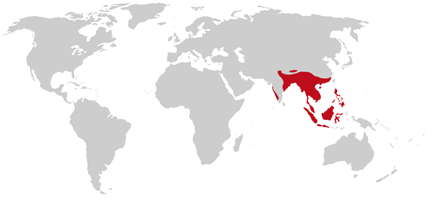
As an example, here is the present distribution of the King Cobra.
Photo: Mad Max
Permission: GNU Free Documentation License, Version 1.2
So the puzzle is, are the engravings of cobras, in which case how did the artist ever see them, or is there some other interpretation possible?
Are the illustrations perhaps maps of rivers proceeding from glacial lakes?
On the other side of the plate there is a large spiral of depressions coming out from the central hole, with several often connected spirals surrounding it.
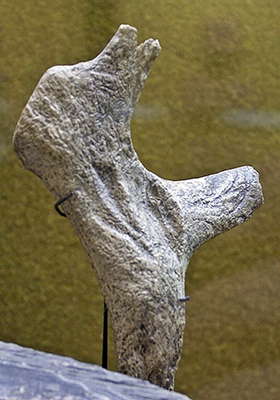
Fragment of reindeer antler with traces of engraving.
Photo: Vladimir Gorodnjanski 2014
Source: The Hermitage Museum, Saint Petersburg
The case for at least some of the venus figures being dolls or toys
I have drawn from Nelson's book for these instances of toys and games amongst people in the polar regions - Don
In places where ivory is plentiful the men appeared to delight in occupying their leisure time in making carvings from that material or from bone, sometimes for use, but frequently merely for pastime, and many little images are made as toys for children. The articles thus produced are not regarded by them as having any particular value, and I was often amused at the delight with which they sold specimens of their work for one or two needles, a brass button, or some similar trifle.

Top from Cape Prince of Wales
Top spinning (Lower Yukon): In winter along the lower Yukon and adjacent region to the south the children of both sexes gather in the kashim, and each child in succession spins its top. The moment the top is spun the owner runs out through the entrance passage and attempts to make a complete circuit of the house and enter again before the top stops spinning. A score is made every time this is done successfully.
Photo: Nelson (1881)
Among other games, the children also have a buzz, usually made by stringing a doubly perforated, flattened disk on a cord. The two ends of the cord are tied together and the ends of. the loop thus formed are held in their hands, so that by tightening and relaxing their hold the disk is caused to twirl about, exactly as is done with a similar toy by [Western] children. These buzzes are usually made of wood, ivory, or bone, although of recent years some are made of metal. I obtained one at St Michael made from the adjoining phalangeal bones of some animal, probably a seal, still united by their cartilage. The string is a single cord of sinew, which is made fast be tween the two middle bones, and at each end of the string is tied a short cross-stick for grasping.
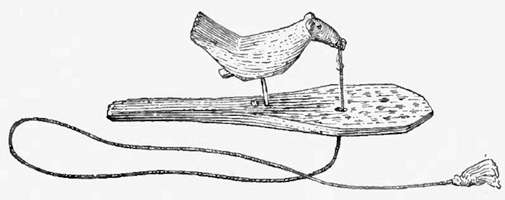
Another toy obtained at St Michael is the image of a woodpecker made of wood fastened to a small wooden spatula by means of a stout quill in place of legs. The surface of the spatula is dotted over with red paint to represent food. By means of a string fastened to the point of the bird s beak and passing down through a hole in the spatula, the child is enabled to pull the bird s head down. On releasing it, the elasticity of the quill throws it up again, thus giving a pecking motion and imitating the movements of feeding. Various toys of this character are made by the Eskimo to represent familiar animals or birds.
Photo: Nelson (1881)

This drawing represents a toy obtained at the village of Sabotnisky, on the lower Yukon. It is a slender, flat rod a little over an inch wide and about 16 inches long, perforated with six round holes at equal intervals along its length, through which is passed in and out a sinew cord, having its ends fastened to the extremities of a small, narrow strip of fur, forming an endless loop. Grasping the rod by the handle at one end, the child draws on the free part of the cord, causing the strip of fur to run in and out of the holes along the surface, thus representing a mouse.
Photo: Nelson (1881)
The Common Murre or Common Guillemot (Uria aalge) is a large auk. It is also known as the Thin-billed Murre in North America. It has a circumpolar distribution, occurring in low-Arctic and boreal waters in the North-Atlantic and North Pacific. It spends most of its time at sea, only coming to land to breed on rocky cliff shores or islands. (text from Wikipedia).
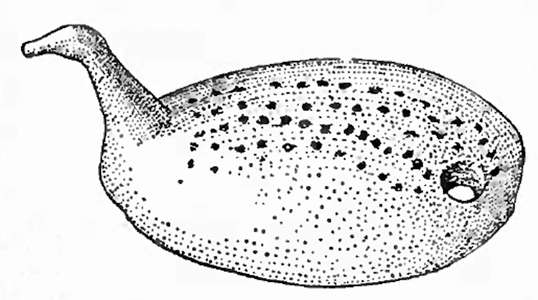
The children also have small figures of birds, seals, and other animals, which their fathers carve in ivory, bone, and wood. Along the seacoast, ivory is the material ordinarily used for making these objects, but among the Eskimo of the tundras, or along the rivers of the interior, bone or deer horn is more commonly employed. The bird images usually represent geese, murres, or other waterfowl, and are made flat upon the lower surface, so that they sit upright. On St Lawrence island, and at various other points which were visited, many of these objects were obtained, of which the toy bird shown here is an example. They are similar in character to the images with which a sort of game is played among the eastern Eskimo.
Photo: Nelson (1881)

In addition to the foregoing objects, dolls made for girls are among the most interesting of the children's toys. On St Lawrence Island two were obtained; these are shown in figure 7 made rudely of wood, and figure 8, which is of ivory.
The makers of these displayed very little skill or artistic ability, as might be expected from their general lack of culture in this direction compared with the people of the adjacent American coast. Along the Alaskan shore wherever I went, as well as along Yukon and Kuskokwim rivers and on Nunivak island, dolls were found in common use. They are usually small images of wood, ivory, or bone.
The dolls usually represent the anatomic details of both sexes, and are from an inch to a foot or more in length. Many of them are carved to represent grotesque human figures, but the majority are simply upright ivory images with the arms by the sides (as represented in figure 2) or held in various positions across the body, sometimes one hand being placed in front and the other behind the back. Many of the natives use hard material merely for the upper half of the body, the legs being made of skin, stuffed with hair or skin to give them a semblance to the natural form.
An ivory figure from Cape Prince of Wales (figure 4) represents an old man with his hands clasped behind the back. The arms and legs are carved free from the body and the work gives evidence of considerable skill and ingenuity.
Photo: Nelson (1881)
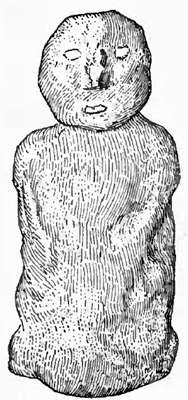
Clay doll
The only instance that I saw of the use of clay among the Eskimo for making images of any kind was a pair of rudely modelled dolls representing the head and body, which were obtained at Razbinsky, on the lower Yukon. One of these dolls is shown here. The inartistic character of these clay figures is in striking contrast to the carvings produced by the same people.
Photo: Nelson (1881)
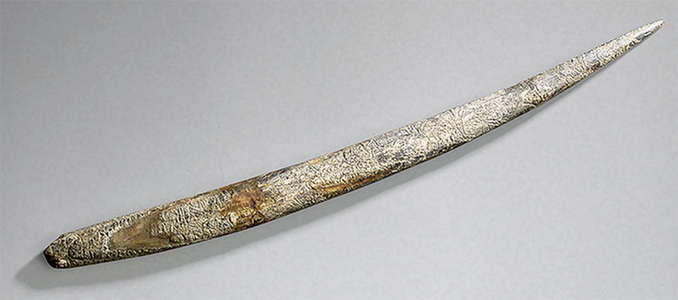
Spike.
Mammoth tusk; carved. Length 300 mm
Mal'ta Site (excavations by M.M. Gerasimov, 1928-1930), Siberia, the River Belaya, near Irkutsk, Russia
Maltinsko-buretskaya Culture. 23 000 - 19 000 BP
Photo and text: http://www.hermitagemuseum.org/
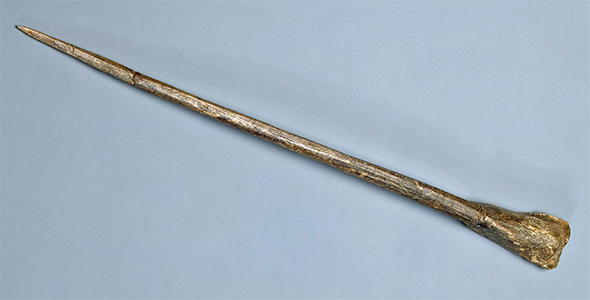
Spike (Hair-pin) with a terminal broadening.
Dog bone; carved and polished. Length 158 mm.
Mal'ta Site (excavations by M.M. Gerasimov, 1928-1930), Siberia, the River Belaya, near Irkutsk, Russia
Maltinsko-buretskaya Culture. 23 000 - 19 000 BP
Photo and text: http://www.hermitagemuseum.org/
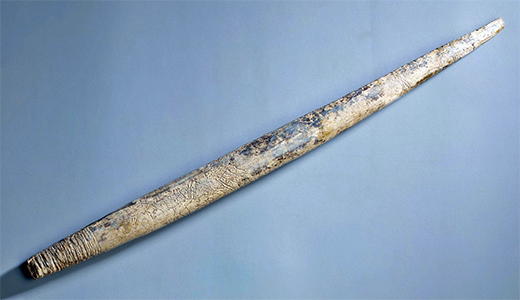
Spike
Mammoth tusk; carved. Length 292 mm
Mal'ta Site (excavations by M.M. Gerasimov, 1928-1930), Siberia, the River Belaya, near Irkutsk, Russia
Maltinsko-buretskaya Culture. 23 000 - 19 000 BP
Photo and text: http://www.hermitagemuseum.org/
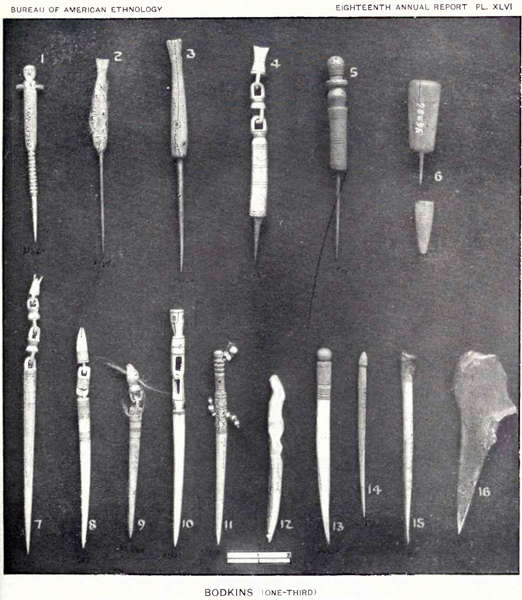
Bodkins from Siberia, collected in the late 19th Century. These were used to make holes in skins so that they could be sewn.
Figure 13, from Kushunuk, is a bodkin made from the hollow wing-bone of a bird. It has a neatly made wooden head, inserted like
a plug in its upper end.
Figure 14, from Razbinsky, is a slender, tapering bodkin of ivory, having its upper end cut into the form of a fish-head.
Figure 15, from Sabotnisky, is a sharp-pointed bodkin, made from the wing-bone of a large bird.
Photo: Nelson (1881)
Mal'ta Lithic Industry
The lithic industry of Mal'ta's main archaeological layer has been only partially published, and we have in particular no indication about the number of tools and proportions represented by the various types. It is also likely that these proportions vary from one dig to another: to take the example of burins, Gerasimov found none during the excavations of 1956, but they are represented, abundant and varied, in the collections of Leningrad and Irkutsk.
This lithic industry, by its technique and its typology, evidently belongs to the Upper Paleolithic. It is based on pebbles, but also on blades, sometimes short and thick. There are many scrapers on blades and flakes. Burins, which appear to be less abundant than at Kostenki or Mizyn are represented by dihedral burins and burins on a truncation, as at Mizyn.
There are many drills, often thin and elongated; there are also retouched blades and points reminiscent of the partly flat faced points of the Western Solutrean. Besides these flint tools, which are medium or small, we found some larger items, often in quartzite.
It should be noted also that there are some scrapers of more or less Mousterian appearance, from prismatic and globular cores as well as numerous discs, most of which seems to be cores.
Overall, although the comparison may not be indicative, it is with the Magdalenian that the Mal'ta industry seems most comparable. The bone industry of the main layer of Mal'ta is rich and varied, and it is also to the Western Magdalenian that it is possible to find somewhat convincing analogies.
It is necessary to mention a discovery which, if not exceptional, is at least extremely rare: during the excavation of 1956, Gerasimov found two handles of reindeer antler, in which were still inserted in one a retouched blade, in the other a a fragment of a blade broken to form a burin. Furthermore, tools of bone or antler has long spears curves up to 250 mm.
Furthermore, tools of bone or antler comprise long curved spears up to 250 mm in length, punches, awls, needles, spatulas, bone splinters in the shape of a dagger etc.
Many of these objects carry a perforation and an outline of geometric patterns formed by sets of engraved parallel lines. These ornaments are many and varied, and we have already written that the station is Mal'ta in this regard, one of the richest, if not the richest of all the Paleolithic of Eurasia.
Text above from Delporte (1979)

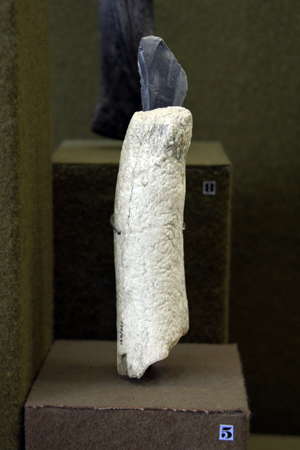
This tool from a reindeer-hunter settlement at Mal'ta in Siberia had a flint blade set into a reindeer antler handle.
This was uncovered during the excavation of 1956, and is an extremely rare find.
In another reindeer antler handle was a fragment of a burin edge shaped from a blade.
Photo: (left, drawing) Sklenar (1988)
Photo: (right, the original tool, seen from the opposite side) Vladimir Gorodnjanski 2007
Source: The Hermitage Museum, Saint Petersburg
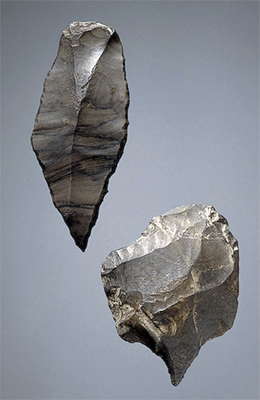
Point and awl.
Flint; chipping technique, with retouching. Lengths 47mm and 62 mm.
Maltinsko-buretskaya Culture. 23 000 - 19 000 BP
Mal'ta Site, Child's Grave (excavations by M.M. Gerasimov, 1929), Siberia, the River Belaya, near Irkutsk, Russia
Photo and text: http://www.hermitagemuseum.org/
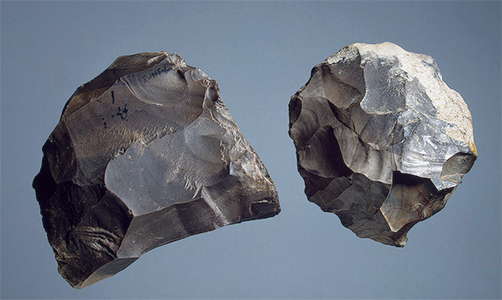
Core and flake.
Flint; chipping technique with retouching. 60 x 60, 56 x 51 mm
Maltinsko-buretskaya Culture. 23 000 - 19 000 BP
Mal'ta Site (Excavations of M.M. Gerasimov, 1928-1930), Siberia, the River Belaya, near Irkutsk, Russia
Photo and text: http://www.hermitagemuseum.org/

1 - Scrapers
2 - Blades
3 - Awls
Mal'ta.
Photo: Vladimir Gorodnjanski 2007
Source: The Hermitage Museum, Saint Petersburg

4 - cores
5 - Pebble tools (the large tools in the foreground)
Mal'ta.
Photo: Vladimir Gorodnjanski 2007
Source: The Hermitage Museum, Saint Petersburg

4 - cores
5 - Pebble tools (the large tools in the foreground)
Mal'ta.
Photo: Vladimir Gorodnjanski 2007
Source: The Hermitage Museum, Saint Petersburg
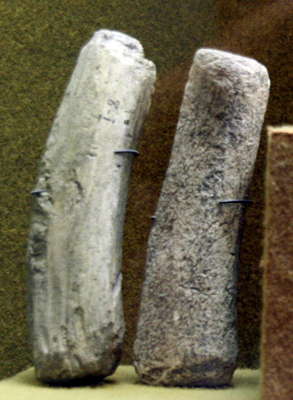
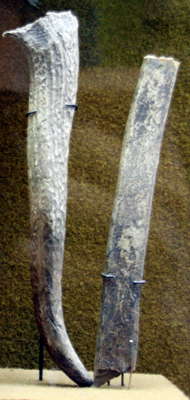
6 - Blanks for tool handles, Mal'ta.
Photo: Vladimir Gorodnjanski 2007
Source: The Hermitage Museum, Saint Petersburg

7 - Bone with marks of cutting, Mal'ta.
This was probably used to strike off flakes and blades from a core.
Photo: Vladimir Gorodnjanski 2007
Source: The Hermitage Museum, Saint Petersburg
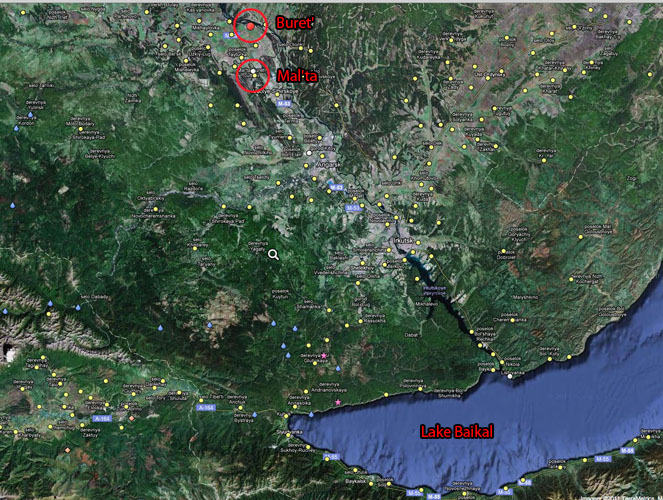
Map showing the Mal'ta site, Buret' and Lake Baikal.
Photo: http://mapcarta.com/16446876#/Map
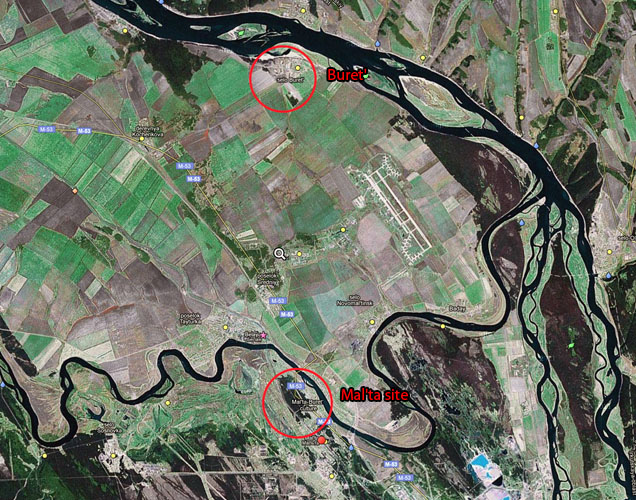
Map showing the Mal'ta site beside the river Belaya, and the Buret' site about 15 km away beside the Angara River, which flows from North to South in this satellite photo.
The word 'selo' on the map means 'village'.
Photo: http://mapcarta.com/16446876#/Map
Decorative Objects of Mal'ta
These ornaments are usually made of ivory, but are sometimes in reindeer antler or bone, especially in bird bone when used for beads; we meet hair pins whose stem is decorated with circles or a spiral, sometimes perforated plates of ivory decorated in various ways, tiaras and bracelets with dots, rings, beads of various types (tubular beads, disk-beads, and waisted beads already reported from Mizyn).
Among these decorative objects, two findings appear to be quite exceptional: the first is a large plate of ivory, measuring 136 mm by 82mm, perforated, with on one side a décor composed of dotted spirals, on the other face three wavy snakes.
The second, collected in the grave of a child with a plate similar to the previous, but less remarkable, consists of a necklace composed of a large bird shaped pendant, six smaller pendants in the shape of the number eight and 12 small discoid beads.
The aviform pendant and the pendants in the form of the number eight are all decorated with the 'pointillé' method. (Pointillé is a decorative technique in which patterns are formed on a surface by a means of punched dots - Don, via Wikipedia )
But the most important part of the art of Mal'ta is represented by an extensive series of works of figurative art. There is, currently, only one engraving: it is a rather clumsily carved on a mammoth ivory plaque. By contrast, sculpture in the round is rich and varied, it is organised into three distinct groups: realistic birds, stylised birds and female figures.
Text above from Delporte (1979)
Numerous rods, hairpins, spindles and other objects of round and flat diameter ornamented with crescent patterns or patterns of depressions have been found from the Mal'ta site. Items of jewellery – headbands, bracelets, breast-ornaments, necklaces, pendants, etc. – are particularly numerous. Headbands (one was discovered on a buried child's skull) and fragments of headbands are made of ivory tiles and are generally ornamented with a pattern of depressions.
Bracelets are of the same material; in one bracelet semiprecious mineral has been used. Ivory plates with pit-ornamentation and snake motifs may have been worn on clothes as breast-ornaments. Numerous are pendants and beads, mostly round but some also triangular, made of mammoth ivory, reindeer antler, pipe bone of birds, vertebrae of fish and stone.
Text above: http-//www.folklore.ee/folklore/vol18/pa06.pdf
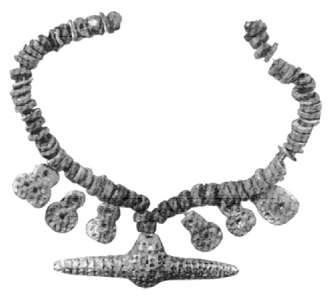
A good example of such finds is this complete necklace, found as a grave good of the child burial. The child was sprinkled with red ochre and charcoal. The necklace consists of one central and six secondary pendants and 120 flat beads. The surface of the pendants is entirely covered with pit-ornamentation.
Photo and text: http-//www.folklore.ee/folklore/vol18/pa06.pdf
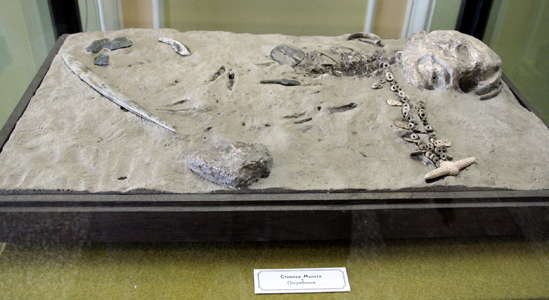
Replica of the child's grave at Mal'ta.
Photo: Vladimir Gorodnjanski 2007
Source: The Hermitage Museum, Saint Petersburg
From a poster at the Hermitage Museum:
At a depth of 41 cm from the upper boundary of the layer, traces of a burial pit (15 x 68 cm) were observed under a pile of contiguous reindeer antlers. Below that, slabs were found standing on edge. Between them, a narrow and long horizontally lying slab was revealed, on which there was a mammoth tooth with traces of red-brown paint. The skeleton of a child lay under the horizontal slab. The deceased was laid on his back with the bones of his left arm extended parallel to the spine. The general impression is that the child is at least 4 years old. The left side of the skull is stained bright red. Traces of paint were also seen on the bones of the skeleton. A rich accompanying inventory was found with the remains.
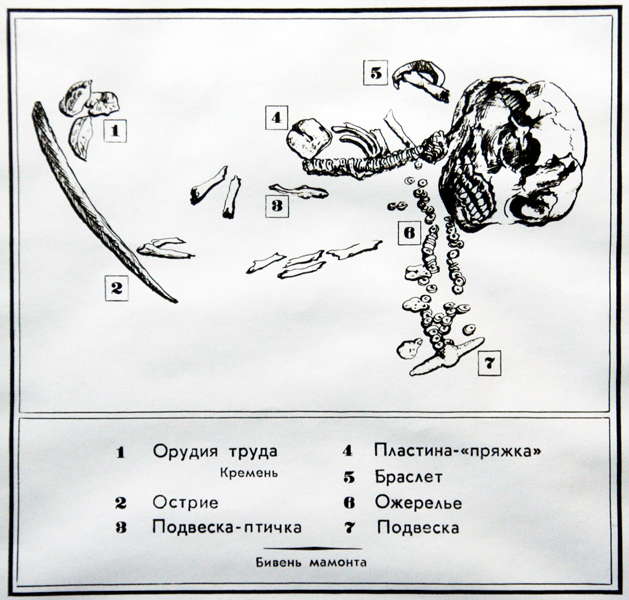
Diagram of the child's grave at Mal'ta.
1 - Flint Tools
2 - Point
3 - Bird Pendant
4 - Plate 'Buckle'
5 - Bracelet
6 - Necklace
7 - Pendant on the end of the necklace
Photo: Vladimir Gorodnjanski 2007
Source: The Hermitage Museum, Saint Petersburg
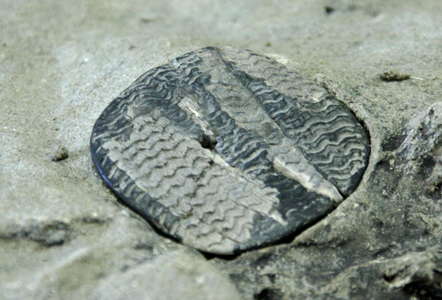
Plate, or buckle. This may have been a breast ornament.
(Note that this is a facsimile. It looks to me like the paler sections are replicas of the shards of the buckle that were actually found, and the darker areas are the best guess for what the rest of the buckle looked like - Don )
Photo: Vladimir Gorodnjanski 2007
Source: The Hermitage Museum, Saint Petersburg
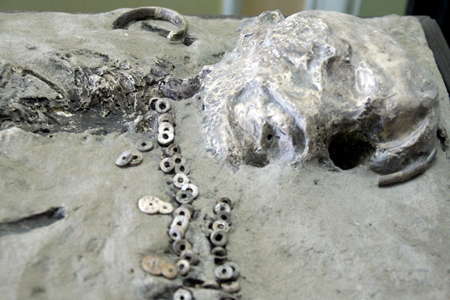
Close up of part of the grave.
(The elements of the necklace are particularly interesting. They could have come from the same artisan as made the 'beads' at Afontova Gora, a few hundred kilometres to North West. Note the large holes, unusual in beads since it takes a lot of effort to make such a large hole well, and that the 'meat' of the bead is relatively narrow in many cases.
In addition, there are some very interesting 'double' beads, with one of the sections larger than the other, and with depressions in the rim of the larger 'bead'. We can see that the bracelet at the back of the display, behind the skull, is strongly curved, taken from the smaller end of a mammoth tusk, while there is a fragment of a diadem, or head band, beside the skull - Don )
Photo: Vladimir Gorodnjanski 2007
Source: The Hermitage Museum, Saint Petersburg
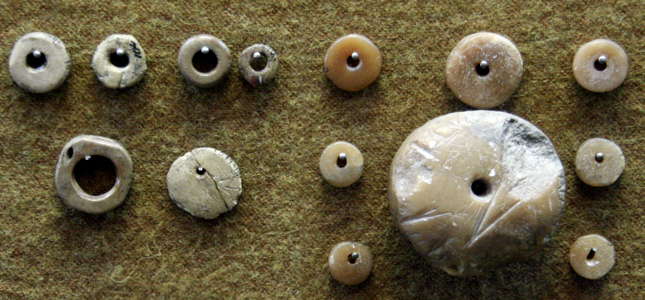
Beads and/or pendants from Afontova Gora for comparison with those above.
Photo: Vladimir Gorodnjanski 2007
Source: The Hermitage Museum, Saint Petersburg

The pendant at the end of the Mal'ta necklace. This is a wonderful photo to have.
Photo: Vladimir Gorodnjanski 2007
Source: The Hermitage Museum, Saint Petersburg
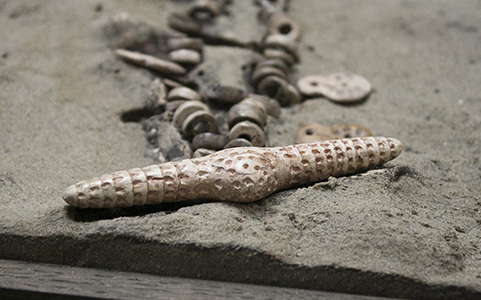
Another great close up of the pendant.
Photo: Vladimir Gorodnjanski 2014
Source: The Hermitage Museum, Saint Petersburg
With regard to the child burial, this note from what is known as the Alekseev manuscript,
http://www.beforebc.de/Related.Subjects/The.Gold.Age/www.drummingnet.com/alekseev/ChapterIV.html
is important:
A burial, that of a child 2-4 years of age, was originally thought to be of a young person with strange morphological, possibly even pathological features.
Actually the burial is of two children i.e. a secondary burial of a newborn placed with the older child. An ornamental plate was found on the remains of the elder child; the many ornamental figures on the plate can be interpreted as possibly a calendar for seasonal events and climatic changes. One interpretation of this unusual burial is that the father of these children had been an interpreter of calendrics, the study of matters relating to the calendar.
Boy's Skeleton In Siberia Raises New Questions About First Americans
Keith Randall
http://tamutimes.tamu.edu/2013/11/20/boys-skeleton-in-siberia-raises-new-questions-about-first-americans/#.Uo0Xqo3M1fU
November 20, 2013
Results from a DNA study of a young boy's skeletal remains believed to be 24 000 years old could turn the archaeological world upside down – it's been proven that nearly 30 percent of modern Native American's ancestry came from this youngster's gene pool, suggesting First Americans came directly from Siberia, according to a research team that includes a Texas A&M University professor, Kelly Graf.
Kelly Graf, assistant professor in the Center for the Study of First Americans and Department of Anthropology at Texas A&M, is part of an international team spearheaded by Eske Willerslev and Maanasa Raghaven from the Centre for GeoGenetics at the University of Copenhagen, Denmark and additional researchers from Sweden, Russia, United Kingdom, University of Chicago and University of California-Berkeley. Their work, funded by the Danish National Science Foundation, Lundbeck Foundation, and the National Science Foundation, is published in the current issue of Nature magazine.
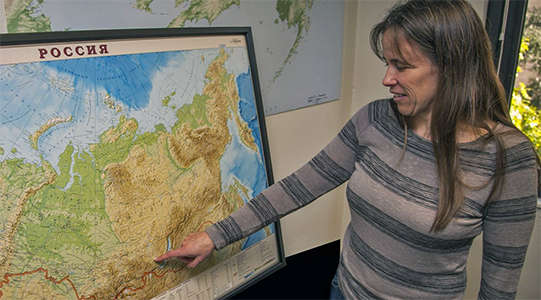
Texas A&M Prof Kelly Graf points to map of Russia where skeleton was found.
Photo: Texas A&M
Source: http://tamutimes.tamu.edu
Graf and Willerslev conceived the project and traveled to the Hermitage State Museum in St. Petersburg, Russia, where the remains are now housed to collect samples for ancient DNA. The skeleton was first discovered in the late 1920s near the village of Mal'ta in south-central Siberia, and since then it has been referred to as "the Mal'ta child" because until this DNA study the biological sex of the skeleton was unknown.
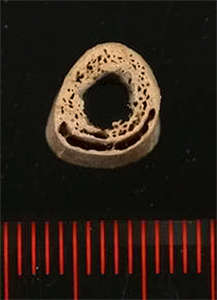
A cross-section of a humerus bone from the 24 000-year-old skeleton found in Siberia. Researchers managed to extract DNA from the bones and trace the ancient individual's genetic lineage.
Photo: Thomas W Stafford, Jr
Source: http://www.nbcnews.com/science/ancient-skeleton-dna-ties-siberia-native-american-origins-2D11624211
"Now we can say with confidence that this individual was a male" says Graf.
Graf helped extract DNA material from the boy's upper arm and "the results surprised all of us quite a bit," she explains.
"It shows he had close genetic ties to today's Native Americans and some western Eurasians, specifically some groups living in central Asia, South Asia, and Europe. Also, he shared close genetic ties with other Ice-Age western Eurasians living in European Russia, Czech Republic and even Germany. We think these Ice-Age people were quite mobile and capable of maintaining a far-reaching gene pool that extended from central Siberia all the way west to central Europe."
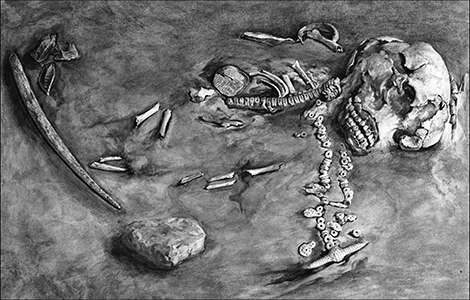
Remains of the 24 000 Year-Old Mal'ta Boy.
Geneticist Connie Mulligan of the University of Florida called the findings 'jaw-dropping'. DNA from this ancient Siberian skeleton offers clues to the first Americans.
Photo: The State Hermitage museum, St. Petersburg
Source: http://siberiantimes.com/science/casestudy/news/24000-year-old-boy-from-lake-baikal-is-scientific-sensation/
Another significant result of the study is that the Mal'ta boy's people were also ancestors of Native Americans, explaining why some early Native American skeletons such as Kennewick Man were interpreted to have some European traits.
"Our study proves that Native Americans ancestors migrated to the Americas from Siberia and not directly from Europe as some have recently suggested," Graf explains.
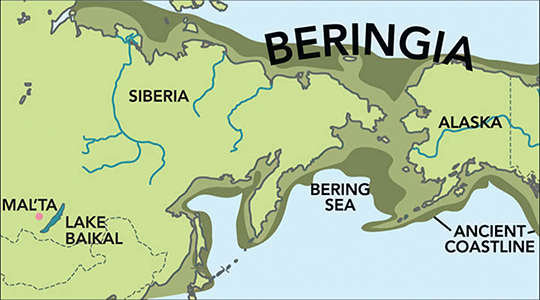
The Mal'ta boy was related to people who later migrated across Beringia to the Americas.
Photo: G.Grullon/Science
Source: http://siberiantimes.com/science/casestudy/news/24000-year-old-boy-from-lake-baikal-is-scientific-sensation/
The DNA work performed on the boy is the oldest complete genome of a human sequenced so far, the study shows. Also found near the boy's remains were flint tools, a beaded necklace and what appears to be pendant-like items, all apparently placed in the burial as grave goods.
The discovery raises new questions about the timing of human entry in Alaska and ultimately North America, a topic hotly debated in First Americans studies.
"Though our results cannot speak directly to this debate, they do indicate Native American ancestors could have been in Beringia—extreme northeastern Russia and Alaska—any time after 24 000 years ago and therefore could have colonized Alaska and the Americas much earlier than 14 500 years ago, the age suggested by the archaeological record."
"What we need to do is continue searching for earlier sites and additional clues to piece together this very big puzzle."
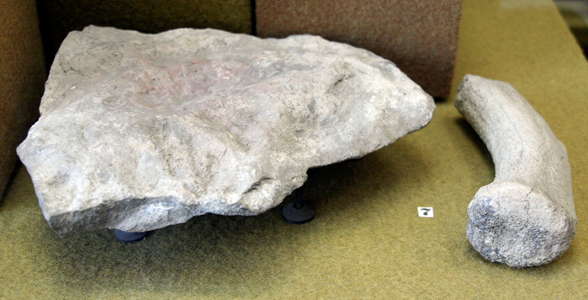
Mortar and pestle for grinding ochre, Mal'ta
Photo: Vladimir Gorodnjanski 2007
Source: The Hermitage Museum, Saint Petersburg
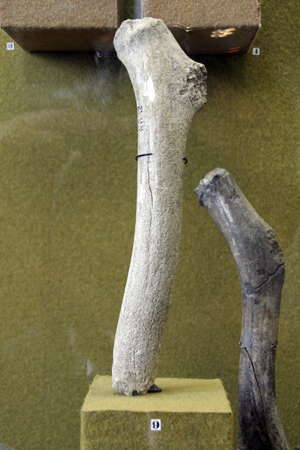
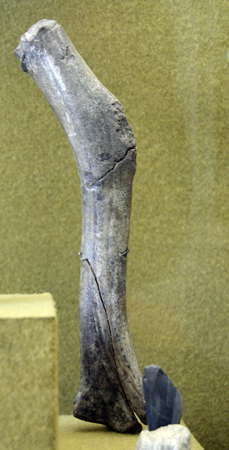
Antlers with signs of use.
(The one on the right seems to have had a particularly hard life! - Don )
Photo: Vladimir Gorodnjanski 2007
Source: The Hermitage Museum, Saint Petersburg
These are identified by the museum card as being beads of quartz crystal.
However they are rhomboidal in shape, which makes them much more likely to be calcite. If this is the case, they are unlikely to have been used as beads, because calcite is usually thought to be too soft and fragile for this purpose, though it is certainly now possible to buy calcite jewellery online, usually for what the sellers allege are their 'spiritual healing' properties. They would have a limited life if worn on a daily basis, and would need to be very carefully looked after.
Quartz crystals are typically clear, not cloudy as these are, and are usually six sided in cross section, and can be beautifully coloured. Typical valued mineralogy collection specimens form six sided prisms.
These crystals are cloudy in aspect, and it is difficult to see why they were thought to be of any worth. They are an unusual shape, but that gives them no more than curiosity value.
My thanks to Mary Johnson for her help in identifying these specimens.
Photo: Vladimir Gorodnjanski 2007
Source: The Hermitage Museum, Saint Petersburg
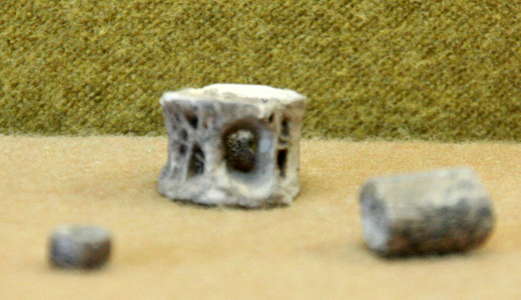
Beads made from a fish vertebra and bones.
Photo: Vladimir Gorodnjanski 2007
Source: The Hermitage Museum, Saint Petersburg
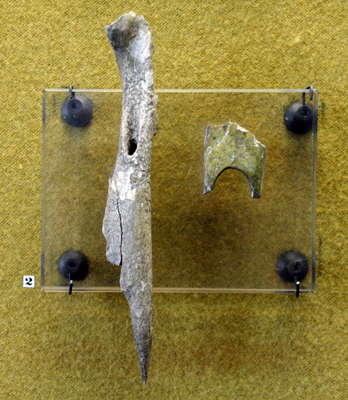
An awl, and a fragment of a tool with a hole.
Photo: Vladimir Gorodnjanski 2007
Source: The Hermitage Museum, Saint Petersburg

Late Paleolithic, 23 000 - 22 000 BP, Asian USSR, Tributary of the Angara River.
Поздний Палеолит, 23 000 - 22 000 лет назад азиатская часть СССР бассейн ангары.
Points and awls.
Photo: Vladimir Gorodnjanski 2007
Source: The Hermitage Museum, Saint Petersburg
Dating of the Mal'ta site:
Radiocarbon Dates From the Oxford AMS System: Archaeometry Datelist 25 p. 234 there is a listing of 5 dates from Mal'ta, all on bone:
OxA-6189 43,100±2400 1/MA-95/S18
OxA-5760 5760±260 2/MA-95/S20
OxA-6191 21,700±160 3/MA-95/S14-170
OxA-6192 20,340±320 4/MA-95/17-327
OxA-6193 21,340±240 5/MA-95/17-764
Comment by Nicholas Cauwe who submitted the samples:
For a long time the site of Mal'ta has been attributed to the middle of the Upper Palaeolithic (Schmider 1992, 445-6), an assumption in harmony with the stratigraphic position, within the loess of the Sartan ice-age. The presence of anthropomorphic sculptures corroborates this point of view, if the comparisons with the Gravettian of Central Europe are correct.
A child burial, discovered in 1929, was dated to the 15th millennium BP (GIN-97: 14 750 t 120). This analysis was never confirmed and was rejected by Russian archaeologists (Boriskovsky 1984, 314; Abramova 1989, 197-9). On the contrary, another site in the same region, Buret, excavated by Ogladnikov in 1936 and from which the lithic and artistic products are similar to those at Mal'ta, is assigned to the 22nd millennium BP (21 190 t 100) (Schmider 1992; Vasil'ev 1995).
During the new excavations at Mal'ta, it became clear that this site contains at least three stages of prehistoric occupation. The first excavators, between 1928 and 1958, had distinguished only one of these, probably due to the perturbation of different layers along the border of the fluviatile terrace. The oldest layer relates to the Middle to Upper Palaeolithic transition (OxA-6189). The second one, which contains the famous anthropomorphic statuettes, is now clearly dated to the Sartan glaciation (OxA-6190, -6191 and -6193). The archaeological deposits dating to this stadial certainly represent an accumulation of many short human occupations. The last layer, which could be dated in the future, seems to belong to the end of the Upper Palaeolithic.
Text above from http://www.palanth.com/legacy/index.php?topic=43.0
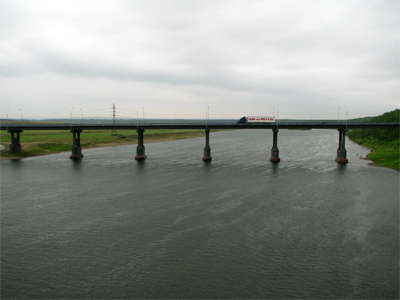
The Belaya river near the Mal'ta site, June 2010.
This is the road bridge where the M-53 (part of the Trans-Siberian Highway) crosses the river, just downstream of the Mal'ta site.
Photo: Volos-t via Panoramio

The Belaya river closer to the Mal'ta site, with the M-53 further downstream.
Photo: Lytkin Dmitriy via Panoramio
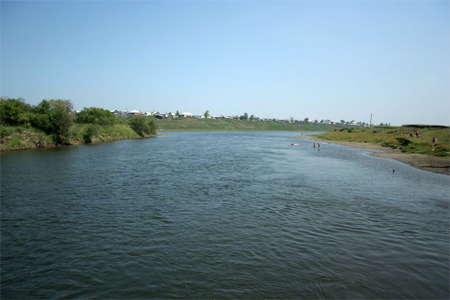
A side channel of the Belaya River, where an island divides the river, opposite the Mal'ta site.
Photo: DobrIgor via Panoramio
Buret' or Bouret or Буреть
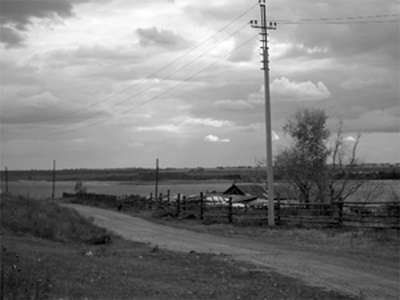
Buret' or Bouret is an archaeological site extremely similar to Mal'ta, and not far away, about 15 Kilometres in a straight line. Buret' is on the right bank of the Angara, at the mouth of the Sukhaia Valley. It was investigated by the famous Siberian archaeologist Alexei Pavlovich Okladnikov. Radiocarbon dating on bone, done in the 1980s gave an age of 21 190±100 BP. Flagstones marked the outlines of four dwellings.
Photo: http://irkipedia.ru/index.php/%D0%91%D1%83%D1%80%D0%B5%D1%82%D1%8C
(Note that one source, http://pressa.irk.ru/sm/2007/39/008001.html , seems to imply that the archaeological site of Buret' has been flooded by the rising waters behind a dam. The site is not clear on this point - Don )
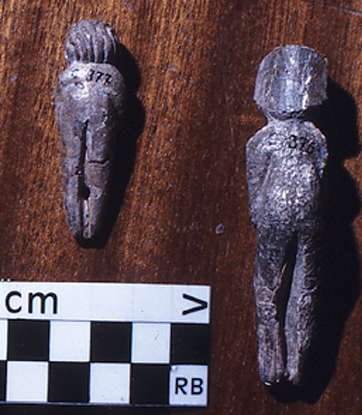
The Buret' figurines Nos 3 and 4.
Photo: Bednarik (2010)

Buret' figurine number three shown in colour above, front, side, and back.
Photo: Abramova (1995)

Buret' figurines and ornamentation / parure.
Photo: Abramova (1995)
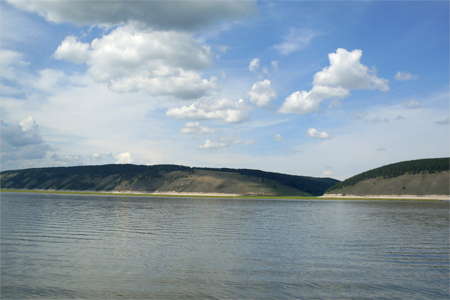
The Angara River, looking from the Buret' side to the opposite bank.
Photo: Lytkin Dmitriy via Panoramio
They are arranged in a series along the river terraces of the Angary River. The best preserved houses in Buret' provided insights into the homes of ancient Siberians. A rectangular base pit was dug in the ground. A narrow corridor led out from that, overlooking the river. Along the edges of the depression in a strict line had been placed 12 femoral bones of mammoths, dug into the earth in the form of supporting pillars. The walls and roof of the dwellings were constructed of interlocking antlers and apparently covered with skins.
( These people did not have much wood to build houses, the few small saplings they found were needed for spears, or perhaps for summer tents, they lived at a time when the whole area was essentially treeless, except perhaps in protected gallery forests of thin and stunted trees where the river had cut a deep valley, creating a slightly milder microclimate, but all around was the steppe and tundra. All they had to build with was the bones and skins of mammoth and reindeer, and thatch from grasses. They could also fill in gaps with mud, in fact cover the entire construction with mud, and make a dwelling for winter that was not just weatherproof, but warm and snug, and would withstand whatever winds and snow the winter storms threw at them. - Don )
The hunters on the banks of the Angara River, have left the ruins of their homes, which tell us much about their lives. In their sculptures we see the world's oldest images of embroidered clothing.
These dressed figurines from the valley of the Angara are the only ones of their kind among all the other women's images of the Upper Palaeolithic, whereas in Europe they had only a few items of clothing in the form of bands, bracelets and belts.
The Siberian figurines had visibly sewn garments such as fur jumpsuits, with the fur outside, tightly fitting the body from head to toe. One of the clearest of this type was found in 1936 at Buret'. The fur of this sewn costume was denoted by semicircular holes and notches, arranged in a rhythmic order in regular rows from top to bottom on the surface of the whole figure. The only part of the body which was exposed was the face. The fur is sharply separated from the convex face by deep narrow grooves. The technique gave the appearance of a thick fluffy fringed hood. The back was broad and flat, but pointed and tapering.
Text translated and adapted from: http://www.siberia-history.ru/node/752
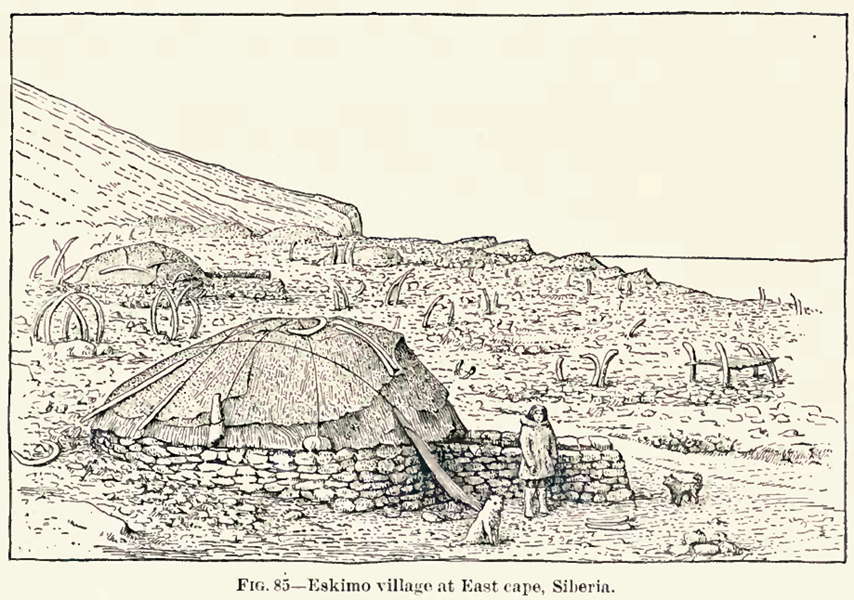
Eskimo village at East Cape, Siberia.
This village is on the Siberian side of the Bering Strait. Note the similarities to the description of the houses found at Buret'.
Although the house foundations are round and made of stone, they include a narrow corridor leading out from the main dwelling. I presume that this corridor was to stop snow drift from piling up at the entrance, and to provide some protection from the wind at the entrance.
What is especially interesting is that the roof is covered with hide, presumably from whales in this instance, but the hides are held down with what at first sight appear to be mammoth bones and tusks!
Note also the bones sticking up out of the ground from presumably abandoned dwellings. All of these bones are of whales, of course, but their use in this context shows how mammoth bones could have been used in continental Siberia by the inhabitants of Mal'ta and Buret'.
Photo: Nelson (1881)
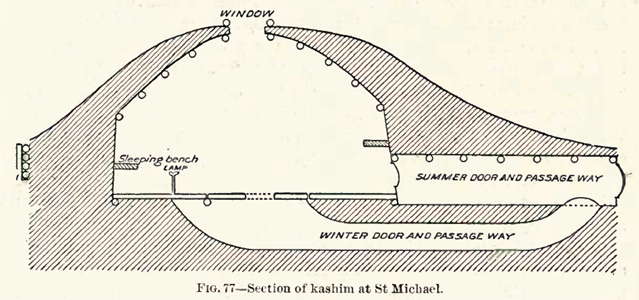
Section of a house in Siberia, possibly similar to those at Buret', showing the corridor to the outside, and the fact that there were two modes of use, one for summer, and the other for winter, which cut down on the loss of heat from the building.
Photo: Nelson (1881)
This description of the houses in the polar regions, in this case at the mouth of the Yukon River, is fascinating, and may have analogues with the houses at Buret', although the Kashim described are large structures, meant to hold all the people of the village. I was particularly interested to find that body heat was sufficient to keep them warm, even in winter!:
In constructing a kashim the logs are laid in the form of a square to the height of 7 or 8 feet; from thence they are drawn in on every side, in alternate courses, until the last are short, and surround a square opening in the roof, directly over the middle of the room, and from 9 to 12 feet above the floor, forming a frame for the smoke hole, which is about 2 or 2 feet in width. If the building is small, it is covered with a heavy layer of earth, but if large, a crib- work is built around it, held together by a frame, so as to inclose the building and form a double wall, inside of which is thrown a heavy layer of earth.
The floor is usually of hewed planks laid close together, and occupies about one-third of the area of the room, in the shape of a square in the center; it is laid on sills at the end so that the planks can readily be taken up; below these there is a pit from 3 to 4 feet deep, in which the fire is built to heat the room for sweat baths, or at rare intervals in winter; but usually the heat from the bodies of the occupants keeps the temperature so high that they remain nude, or partly so, much of the time, even in winter. Other planks usually cover the ground back to the walls, although in many places, especially where wood is scarce, the floor of this portion of the room consists merely of the earth, beaten hard.
The entrance consists of a long, roofed passage, built of logs and covered with earth ; the outer end of this is faced with planks, over which is a square, round, or arched doorway leading into the room in summer, when it is closed only by a bearskin curtain. In winter this entrance, which is above the ground, is closed tightly, and a round hole in the floor near the outer end of the upper passage leads through a low tunnel, along which the people pass on their hands and knees to the fire pit, and thence through a circular or oval hole to the middle of the room. These rooms are from 12 to 25 feet square. Text above: Nelson (1881)
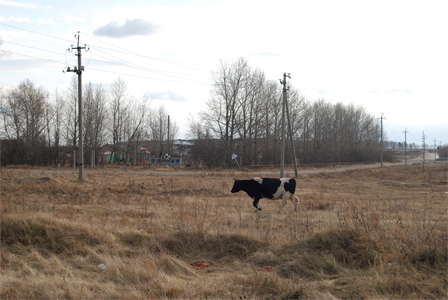
Scene on the outskirts of Buret' village.
Photo: Leonid Arshinskiy via Panoramio
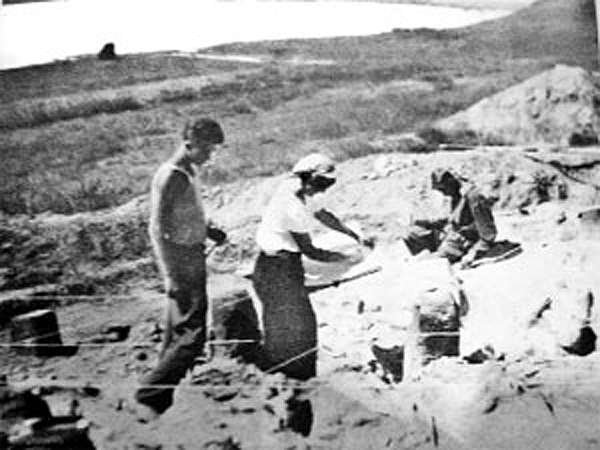
At the Buret' excavations in 1940.
Seated, AP Okladnikov, director of the excavations.
Left, historian Vasily Fedorovich Shaman as a young man, a second year Geography student at the time.
Photo: http://pressa.irk.ru/kopeika/2008/06/011001.html

Academician Alexey Okladnikov (right) with Academician Anatoly Derevyanko (left) during an archaeological expedition.
Photo: Science First Hand, Hermitage Museum
Source: http://siberiantimes.com/
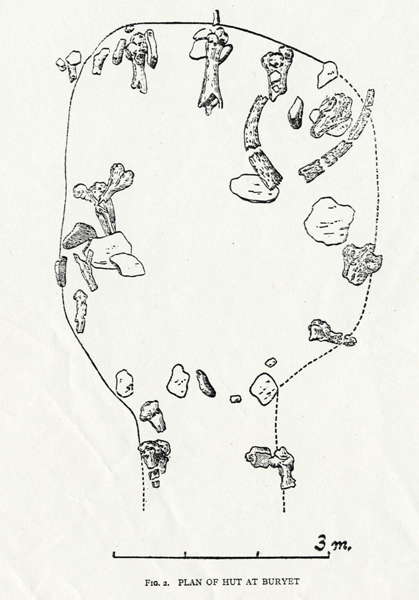
Plan of hut at Buryet
(note the spelling, translation from Russian often results in a plethora of different spellings - Don )
…Bones such as rhinoceros skulls. Just within the margins thus defined lay phalange bones of mammoth, often under prostrate slabs but spaced at regular intervals round the depression. An extra pair, further from the centre than the rest, flanked what is supposed to have been the entrance.
Okladnikov supposes that these bones helped support the roof but not as pillars so much as struts upon the tops of which would have been supported inward-slanting poles the lower ends of which would have rested on the ground where the slabs stood along the margins of the depression.
On the latter's floor were found numerous reindeer antlers, sometimes interlocked. These, the excavator suggests, were fallen from the roof where they had once formed a sort of lattice between the converging poles to serve as a frame supporting a covering of skins.
Photo and text: Childe (1950)
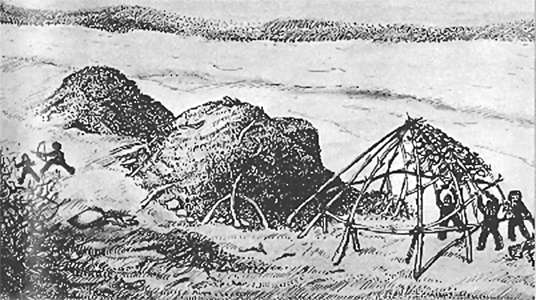
Upper Paleolithic huts from Buret', Siberia. These structures date from about 12 000 BP
Photo: http://www.afghanchamber.com/history/stoneages.htm
Stone tools found at the site include prismatic and conical yadrischa, blades with retouch along the edges and ends of the tip, scrapers, ankoshi on blades, disc-guns, punches, scrapers. Six female figurines were found (from mammoth ivory and one of the coil) and bird figurines. The group is represented by jade jewellery disc pendant with a hole and made of a coil.
In Paleolithic times the area was treeless tundra-steppe region, and the inhabitants of Buret' were probably hunters of mammoths and reindeer.
Text above adapted from: http://library.thinkquest.org/27130/ru/4_2_1.htm
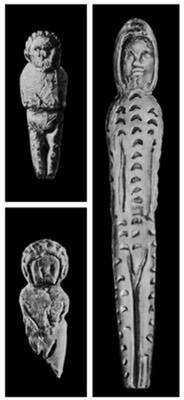
Buret' figurines made of mammoth ivory. (The photo on the right seems almost photographic in its depiction of the human face. It may have been photoshopped - Don )
It was discovered and investigated by Okladnikov in 1936, 1937, and 1939. Together with Paleolithic stone and bone tools were found the bones of rhinoceros, mammoths, reindeer, bison and other animals of the glacial period. The remains of four houses were uncovered, one of which was dug into the ground to 1 metre, and the rest at ground level.
The materials for the construction of dwellings were the bones of mammoths, rhinoceroses, skulls, and reindeer antlers. A bird figurine was found, as well as five female figurines. One of the figurines was a statuette of a woman dressed in an arctic fur suit with a hood.
The figure on the right, found in 1936, has dimensions of 122 x 20 x 15 mm
Date: 23 000 - 22 000 BP.
The robe is very similar to that used by modern natives of northern Siberia. Most likely the ancient Siberians living in the harsh conditions of the Ice Age sewed their clothes from furs which effectively protected the entire body.
Present Location: Hermitage Museum, Saint Petersburg
Photo and text: http://dic.academic.ru/dic.nsf/bse/71794/%D0%91%D1%83%D1%80%D0%B5%D1%82%D1%8C
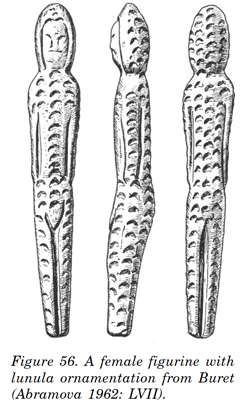
Other views of this important figurine.
Photo: http-//www.folklore.ee/folklore/vol18/pa06.pdf
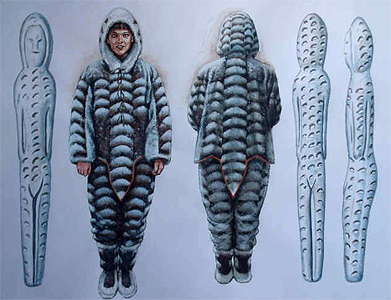
Fur clothing which may have been used at Buret', based on the figurine.
Photo: © Libor Balák
Source: http://paleoetnologie.wz.cz/anglperson.htm
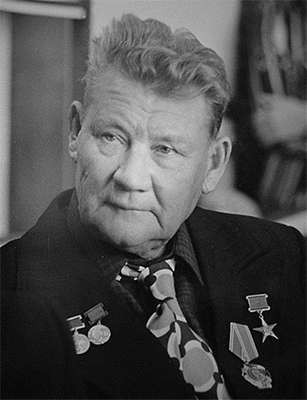
Alexey Pavlovich Okladnikov (1908 - 1981) was born on October 3rd, 1908, into a teacher's family in the small village of Typta ascribed to the rural settlement Konstantinovka. The village was securely hidden in the taiga along the upper Lena waters. During the long winter nights, Okladnikov loved listening to his grandmother's tales for hours. The light of a wooden splinter quavered inside a metallic casing, illuminating a large Russian oven, while flickering shadows cowered in the corners. Listening to old fairy tales, folk myths, and legends, the boy flew away in his dreams together with the creatures in the folk tales.
Okladnikov inherited genetically much from his ancestors who earned their living in the taiga at the risk of their lives, primarily an indomitable passion for travelling, a strong spirit, indefatigability, and simplicity - qualities useful in any expedition. For more than fifty years, he annually left home for expeditions. He loved the nomadic life, despite all its hardships, and called himself a nomad.
Photo and text: Original Russian Text © A.P. Derevyanko, 2008, published in Vestnik Rossiiskoi Akademii Nauk, 2008, Vol. 78, No. 9, pp. 800–809.
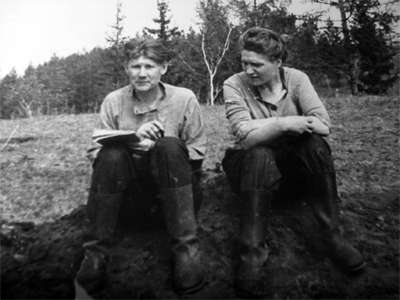
Aleksei P. Okladnikov and Vera D. Zaporozhskaya in 1936, at excavations of the Paleolithic site of Buret', Angara River.
Archive of E. A. Okladnikova, St. Petersburg, 2008
Photo and text: http://www.nps.gov/akso/beringia/beringia/library/The-Early-Sites-of-Cape-Baranov.pdf
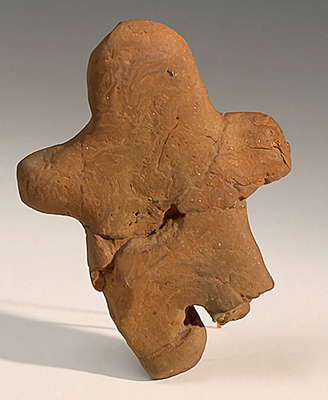
Anthropomorphic Figurine
22 000 - 20 000 BP.
Fired clay
H 102 mm
Maininsk settlement, Siberia
This figurine, 96 mm high, is made from reddish-brown fired clay. In profile it is slightly bent, its arms, legs and head conveyed by projections. It is considered to be unique, for this is the first clay object of the Eneolithic era uncovered on Russian territory.
(Note - this looks to me more like a child's doll than a venus figure made for spiritual or shaman purposes - Don )
Photo and text: Hermitage Museum, Saint Petersburg, Russia.
From http://nihilum.republika.pl/Str_Maininsk.htm :
At Maininsk (Maininskaya) in layer No. 5 was found this burnt clay figurine. Dated at about 16 500 years. An unusual discovery is also that at Maininsk there was an oval building, with the floor paved with flagstones.
This is an open air site at Maininskaya (near Maina), on the left bank of the Yenisei (Enisey) River in Siberia.
From http://vm.kemsu.ru/en/palaeolith/plastic/maina.html :
A statuette made of burnt reddish-brown clay with an admixture of separate sand grains. Height - 96 mm. Found in the Maininskaya site (Sayansky canyon, the left bank of the Yenisei, near the Maina settlement). Date according 14C of the layer where the statuette has been found - 16 176 ± 180 BP.
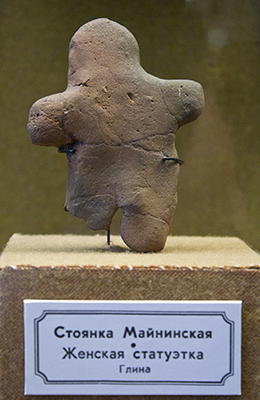
Anthropomorphic figurine.
This looks like an extremely well made facsimile.
Photo: Vladimir Gorodnjanski 2014
Source: The Hermitage Museum, Saint Petersburg
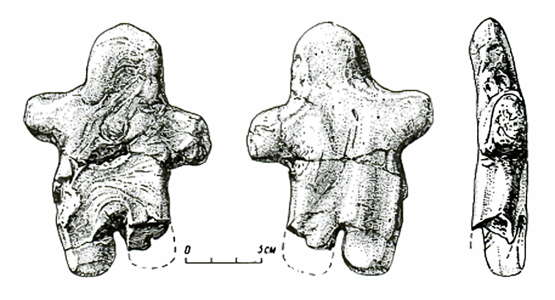
Anthropomorphic Figurine, showing front, back and side.
Maininsk settlement, Siberia
Photo: Abramova (1995)

Maininskaya (red marker) in relation to Lake Baikal
Photo: http://loc.alize.us/#/geo:53.370221,95.877686,7,k/
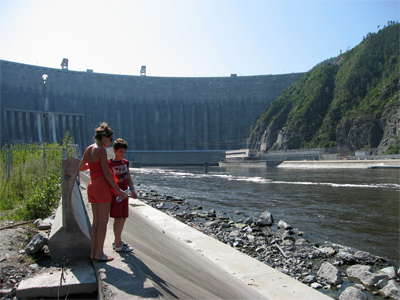
The Yenisei River and the Sayansky canyon have been tamed by a large dam. It is not clear whether this has destroyed the Mainskaya site.
Photo: zhaffsky, http://www.flickr.com/photos/zhaffsky/300944658/
Date: 2006.08.04, Beysky, Khakasiya, Ru.
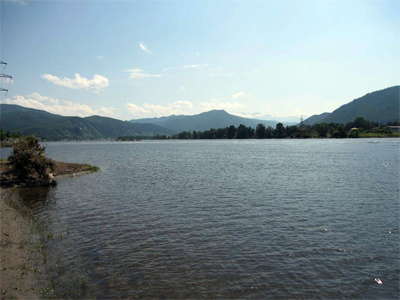
The Yenisei River
Photo: Sergey, http://www.geolocation.ws/v/L/439575893/yenisei-scenery/en
Position: 52.901448N 91.480923E, Russia Krasnoyarsk Krai
Permission: Attribution-ShareAlike 2.0 Generic
References
- Abramova Z., 1995: L'Art paléolithique d'Europe orientale et de Sibérie., Grenoble: Jérôme Millon.
- Bednarik R., 2010: An overview of Asian palaeoart of the Pleistocene, IFRAO Congress, September 2010 – Symposium: Pleistocene art of Asia (Pre-Acts)
- Childe, V.G., 1950: Cave Men's Buildings Antiquity, Volume: 24 Number: 93 Page: 4–11
- Clark G., 1967: The Stone Age Hunters, McGraw-Hill, 1967
- Cohen C., 2003: La femme des origines. Images de la femme dans la préhistoire occidentale,, Paris, Belin-Herscher, 2003, 191 pages.
- Delporte H., 1979: L'image de la femme dans l'art préhistorique, Paris, Picard.
- Jelinek J., 1972: Das grosse Bilderlexikon des Menschen in der Vorzeit, Gütersloh. Bertelsmann-Lexikon-Verlag, P. 333
- Nelson, E., 1881: Eskimos about the Bering Strait
- Soffer, O., Adovasio, M., Hyland D., 2001: Reply to 'More on the Venus Figurines', Current Anthropology, Volume 42, Number 3, June 2001, pp 410-412
